The history of Dynamic in ads
#51

Posted 23 October 2010 - 01:33 PM
It's cool to read these old articles and see what was popular in the day and try to build it yourself.
(even though it may have been hogwash anyway)
Z
- MarcusPHagen likes this

#52

Posted 23 October 2010 - 03:38 PM
OK, back from the vault.I'm looking forward to the second part of the Speed Secrets article.
And this is what I found in MCS, the continuation of MC&T, for the rest of 1968, as far as ol' Dynamic is concerned:
(And only two pages — promise!
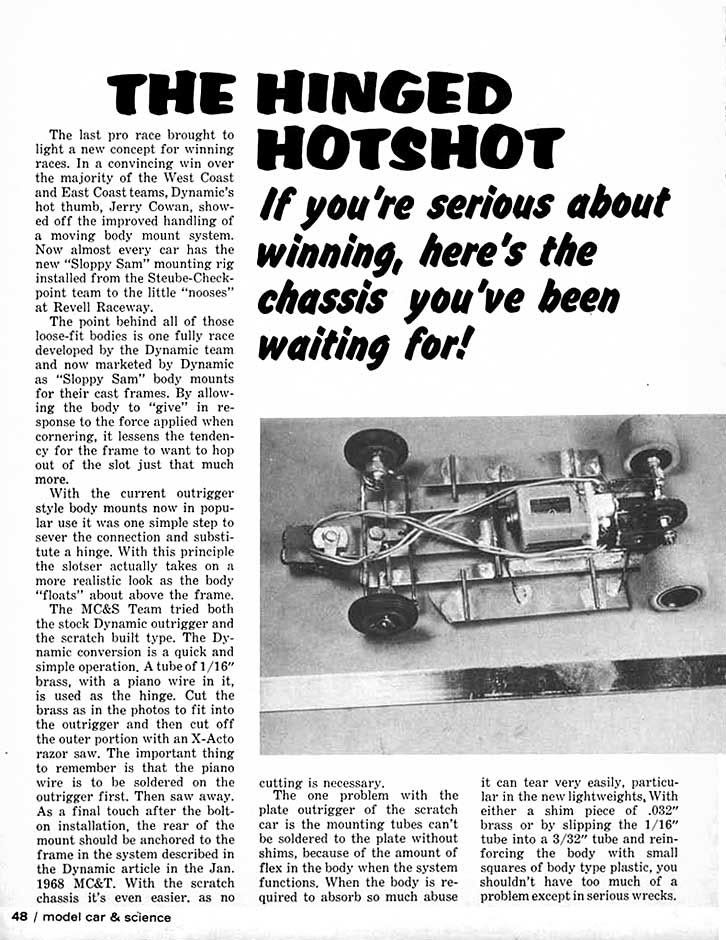
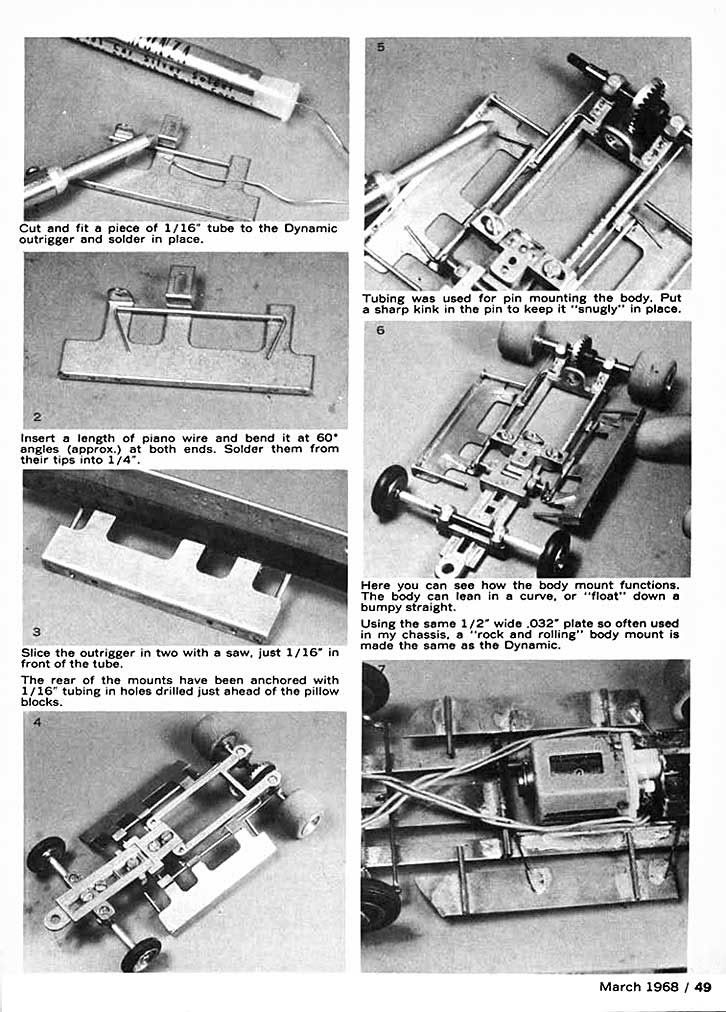
Overseas Observer
#53

Posted 24 October 2010 - 09:14 AM
#54

Posted 26 October 2010 - 02:17 AM
most of the next. It's dead silent, ad-wise, from Dynamic in Van Nuys for more than a year.
Then suddenly, in the very last month of 1968, new signs of life from Dynamic appears out of the blue, and simultaneously in
the remaining two of ”The Big Three” national slot car mags, Model Car Science and Car Model. It's small and unassuming ad
featuring a completely new line of slot car products.
Gone are the typical profile of Dynamic, the die-cast aluminum parts. Instead, the new setup is all brass and music wire. It's a
new tune for a new age in slot racing — and in scratch building. (As an aside, the company's address has also changed, from
13775 to 13309 Saticoy Street...).
The first "new era" Dynamic ad in Car Model, December 1968...
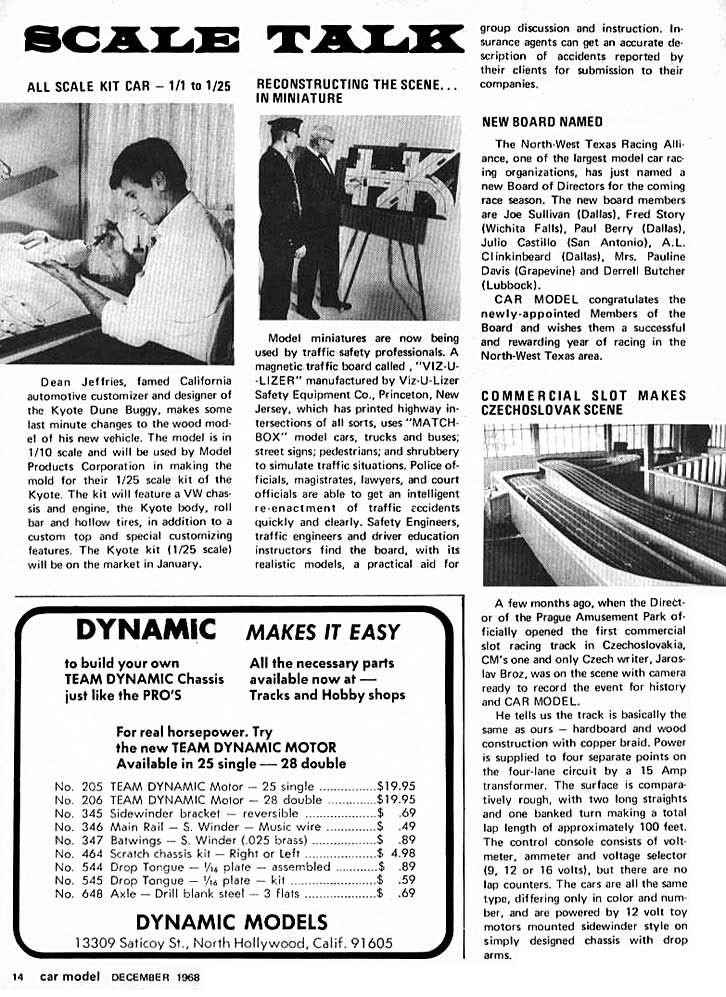
...and in Model Car Science, also December 1968.
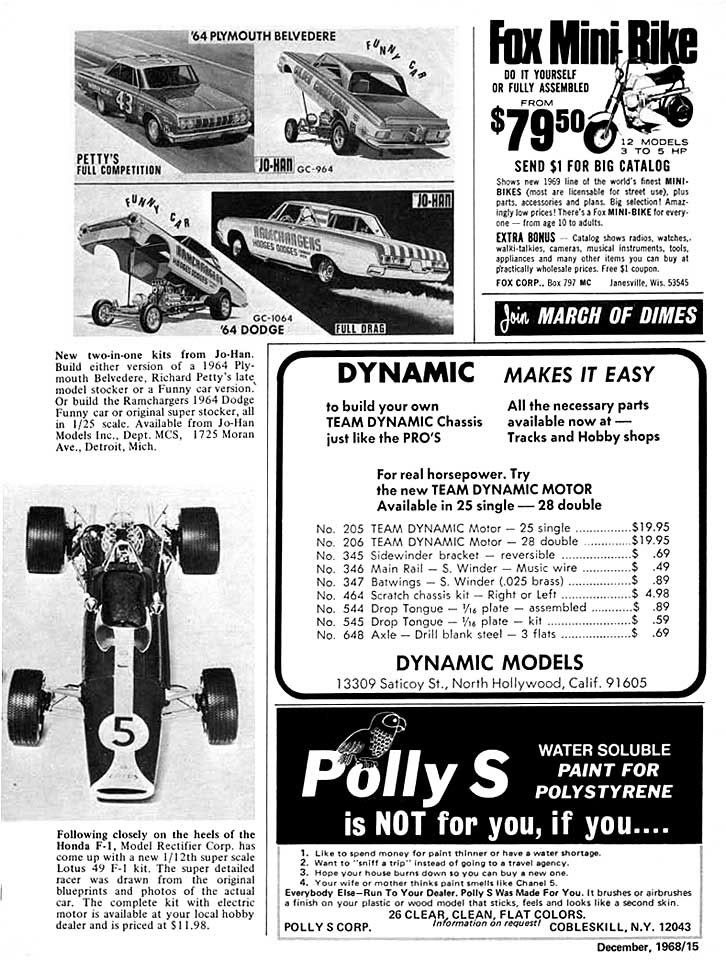
In 1969 Dynamic is back in the game, but to a much lesser extent and in much smaller sizes than in the previous ”golden” years.
Also, the primary vehicle for this new and smaller Dynamic ad campaign in the new era has shifted. Focus is no longer in the
Model Car Science magazine in Dynamic's own home ground California, but in the New York-based Car Model.
January 1969, Car Model: ”Introducing the great new fleet from Dynamic”. RTR cars with ”Droop snoot, Sloppy Sam & Outriggers”.
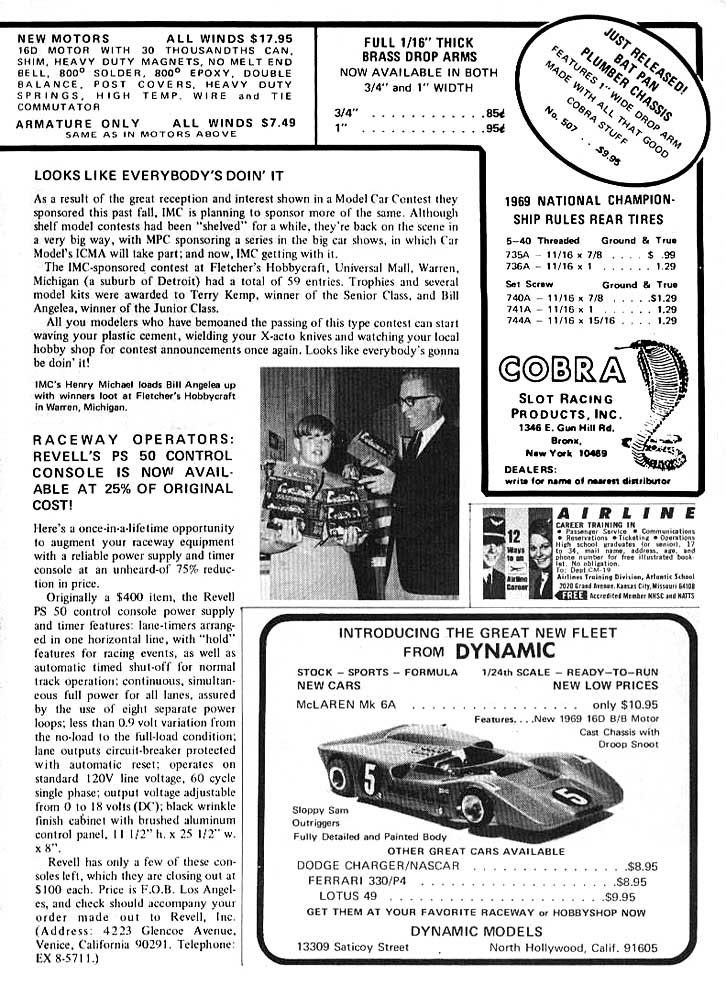
February 1969, Car Model: ”Another winner in the great new fleet”. Adding ”Low Profile Flag, Hi-Crown Front Tires & Suspension”
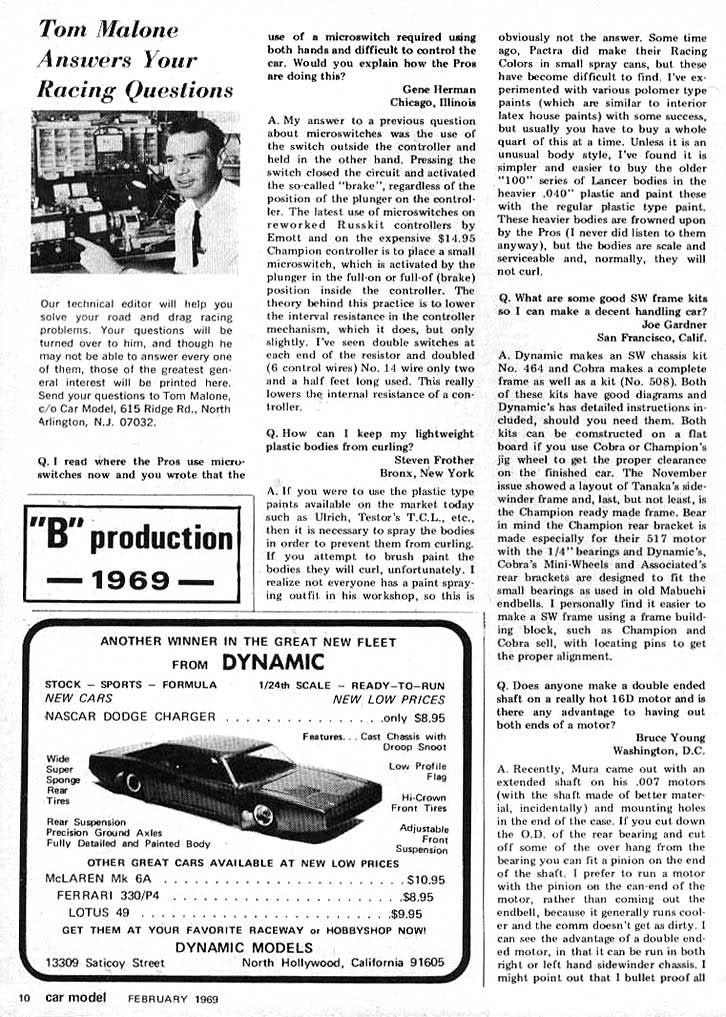
March 1969, Car Model: Introducing the ProFormance line. Anglewinder brass chassis, batwings & handling bodies — 1/24 & 1/32.
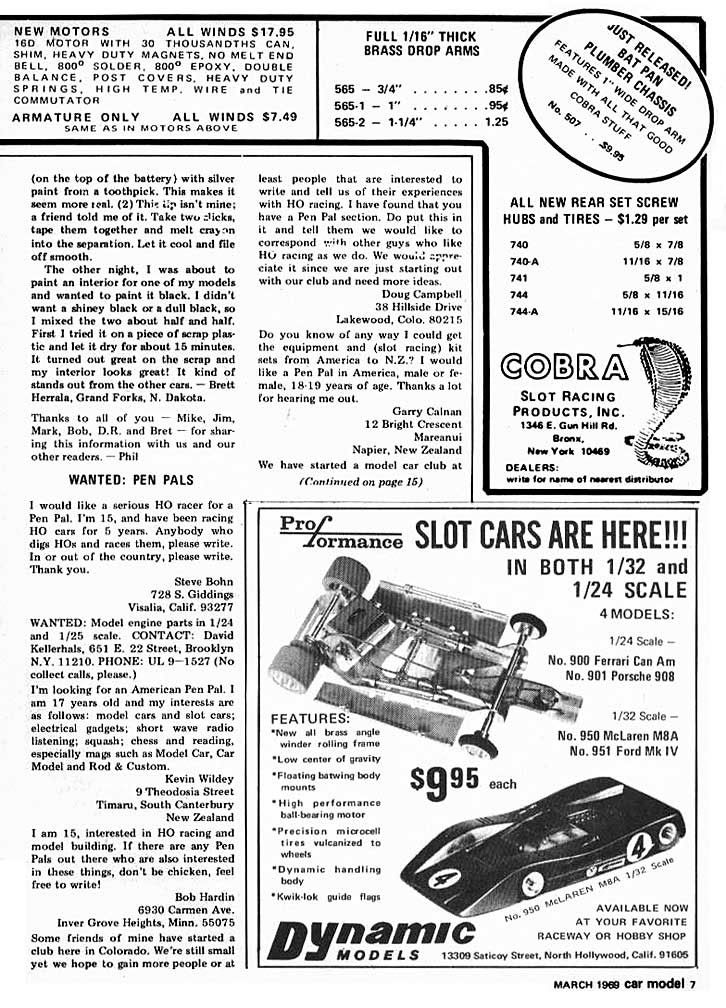
April 1969, Car Model: More ProFormance, also illustrating both the new 1/32 and 1/24 AW cars with stamped brass chassis.
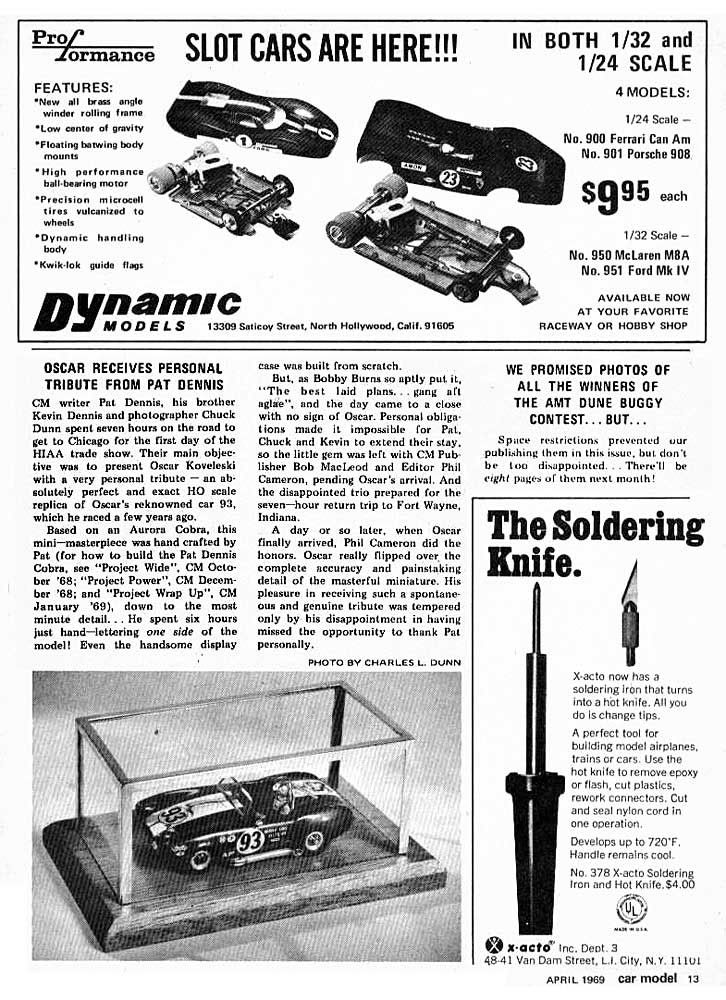
-----------------------------------------------------------------------------
May 1969, ad-free month: No sign of Dynamic anywhere.
-----------------------------------------------------------------------------
June 1969, Model Car Science: The first Dynamic ad of the year in MCS. Also not to appear in Car Model.
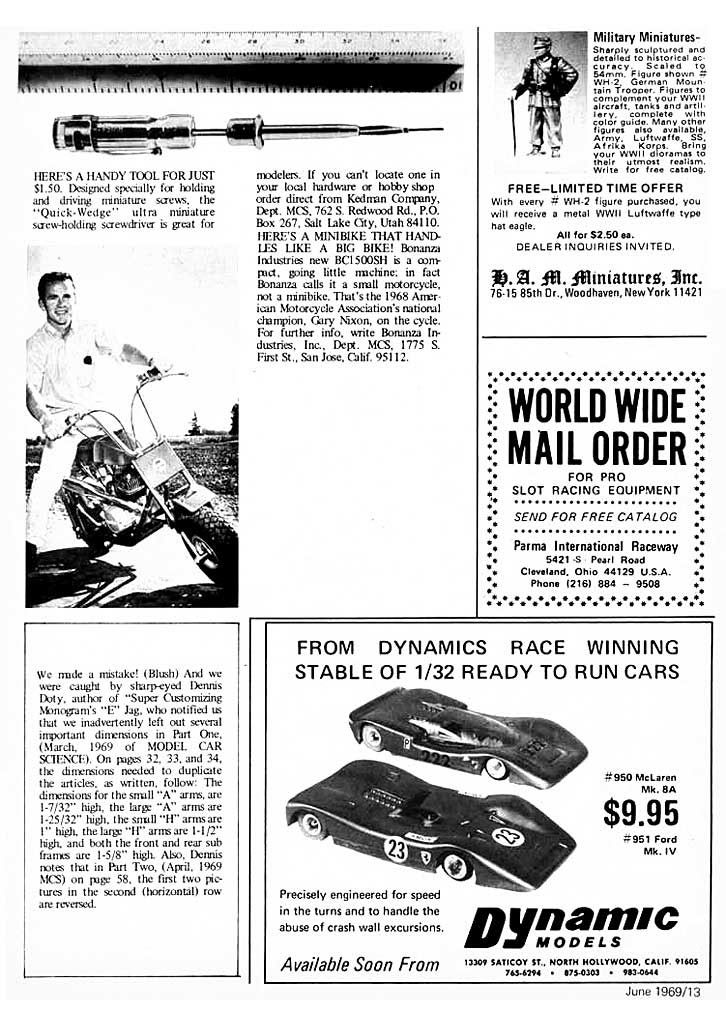
July 1969, Car Model: Introducing ”The Big Z” — The chassis that may do away with turn marshals...
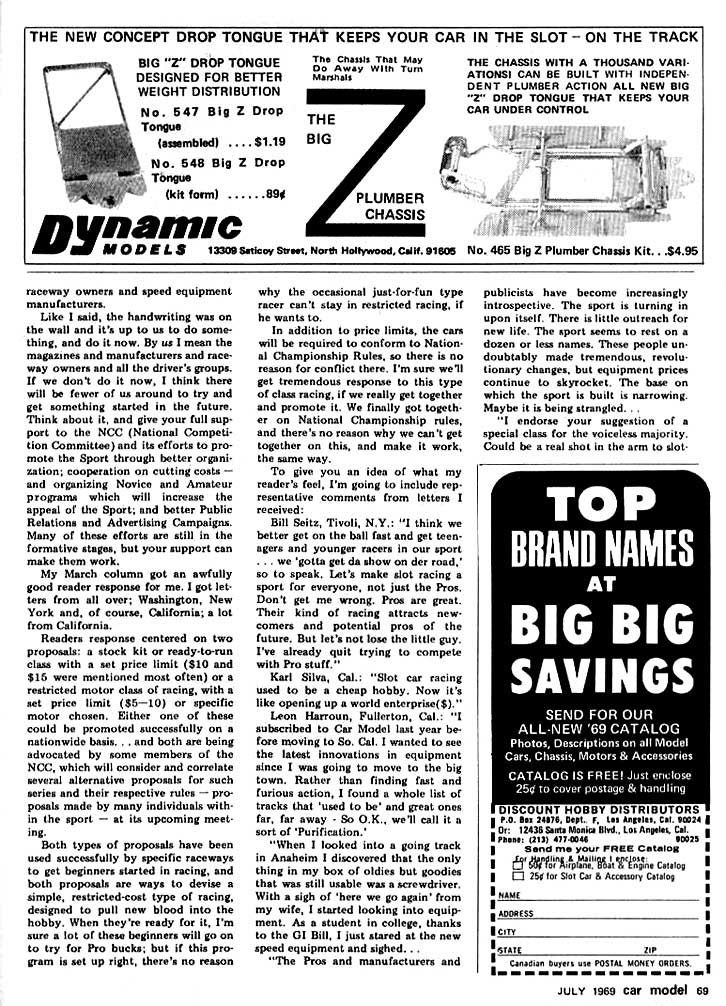
August 1969, Model Car Science: The second (and last) Dynamic ad of the year in MCS. Big Z again. (And also not in Car Model.)

------------------------------------------------------------------------------------------------------
September 1969, another Dynamic ad-free month: Nothing in CM or MCS.
------------------------------------------------------------------------------------------------------
October 1969,Car Model: Introducing new cars — and now the Dynamic RTR line is also ”Group 12 NCC Approved”.
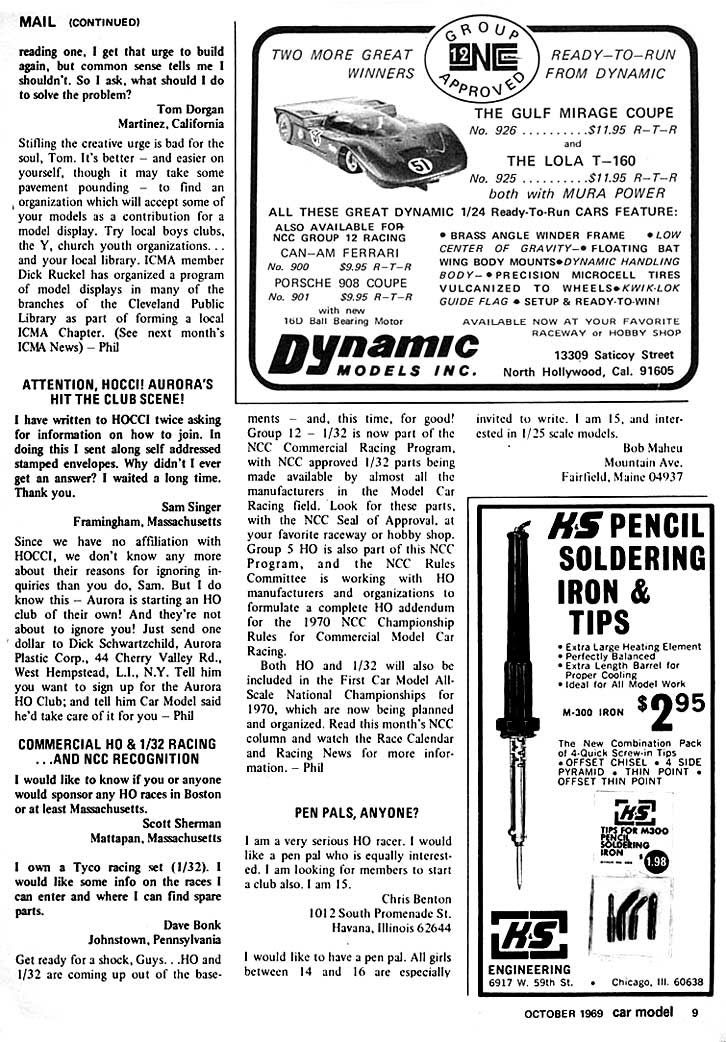
November 1969, Car Model: Nothing new — same ad as in the previous month.
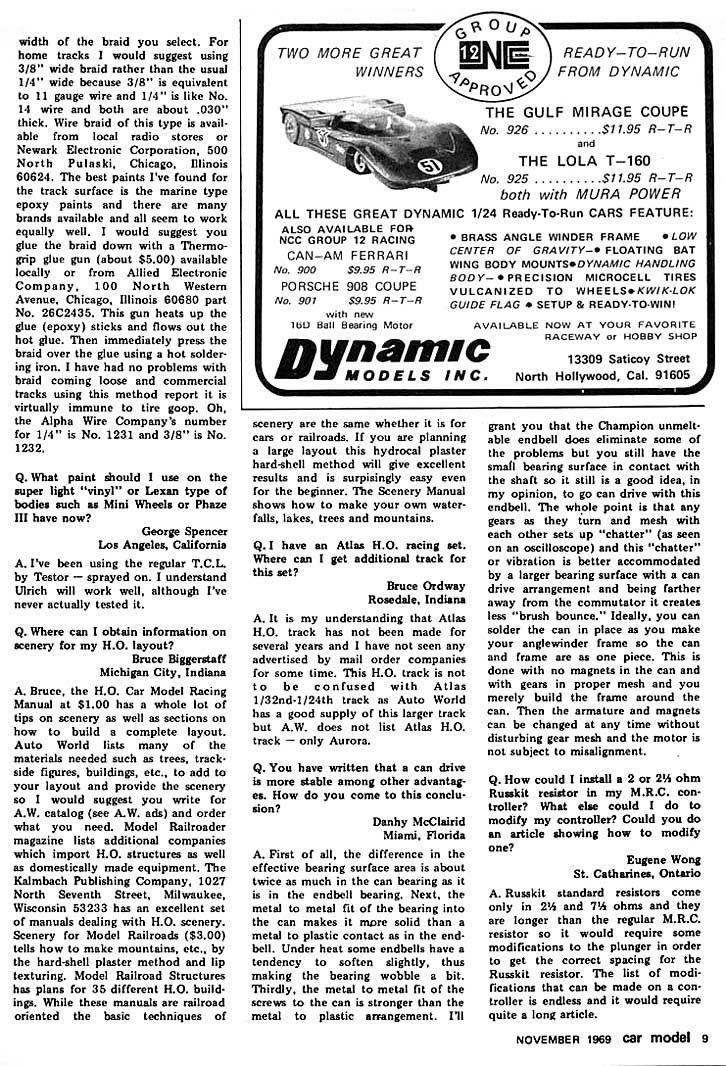
December 1969, Car Model: Back in time — and returning to the ad for april...
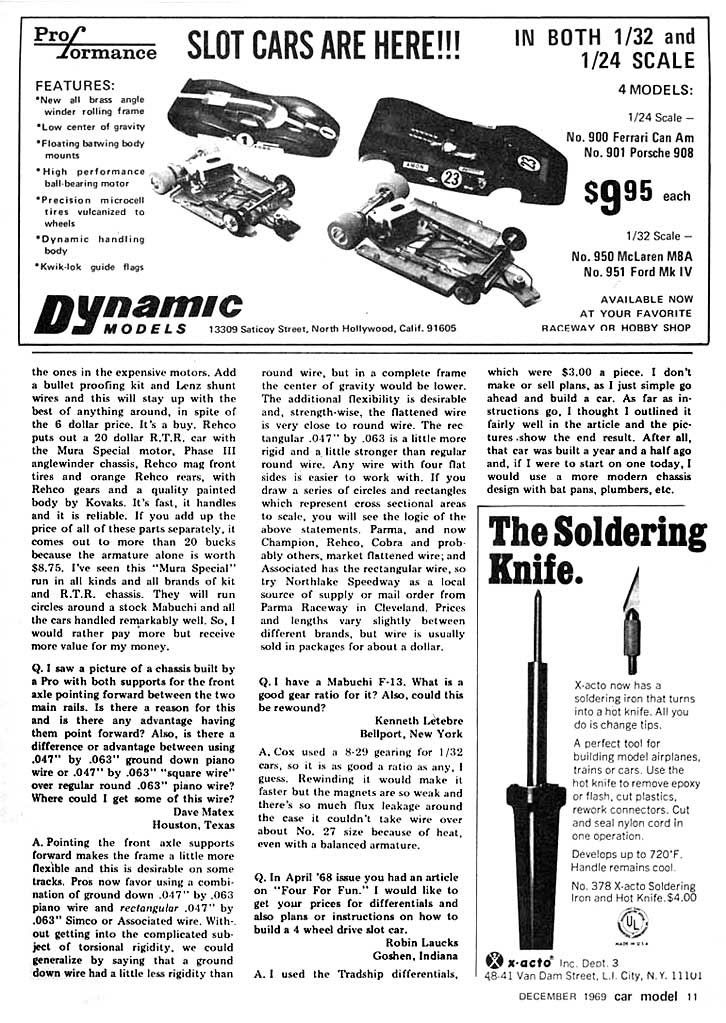
[To be continued...]
(And to sidejobjon: Don't worry, "the small guys" are NOT forgotten, you just have to be patient...
Overseas Observer
#55

Posted 26 October 2010 - 01:31 PM
This last was a lightning bolt to me. In '68 we were meeting for the "NCC" which became USRA. Tracks were closing and the survivors all had a low-buck class which became the "Group 12" NCC rules. The short version was that the sum of the parts or the kit had to retail at less than 12.95. In a nonce, not in these ads, all the Dynamics KITS that were cheap enough got "NCC Group 12" stickers on the box.
And then those stamped brass anglewinders were out for Christmas. I was "poaching" by driving to tracks where I wasn't known and winning the Group 12 races, and suddenly, with this anglewinder, people had cars that were just good, not "kid good".
In '91 when the local track took up Flexis, the rules said "Any Group 10 or 12 chassis past or present". I got to run one of my Dynamics briefly. Being all dialed it, it was quick, immediately protested, and the rule was changed to "currently available". Neat cars.
Anyway, over in the 1/32 D3 stuff, the recent anglewinder race involved cars without "proper" three-sided anglewinder brackets. I do not remember these being standard back then, so I wondered if the rules writer was remembering the brackets in the ads above. The 1/24 brackets did feature in hundreds of local chassis back then, but quickly disappeared, like in weeks.
Fun times.
Fate
3/6/48-1/1/12
Requiescat in Pace
#56

Posted 26 October 2010 - 05:18 PM
Model Car Science, May 1969: The stamped brass chassis in 1/32 is noticed.
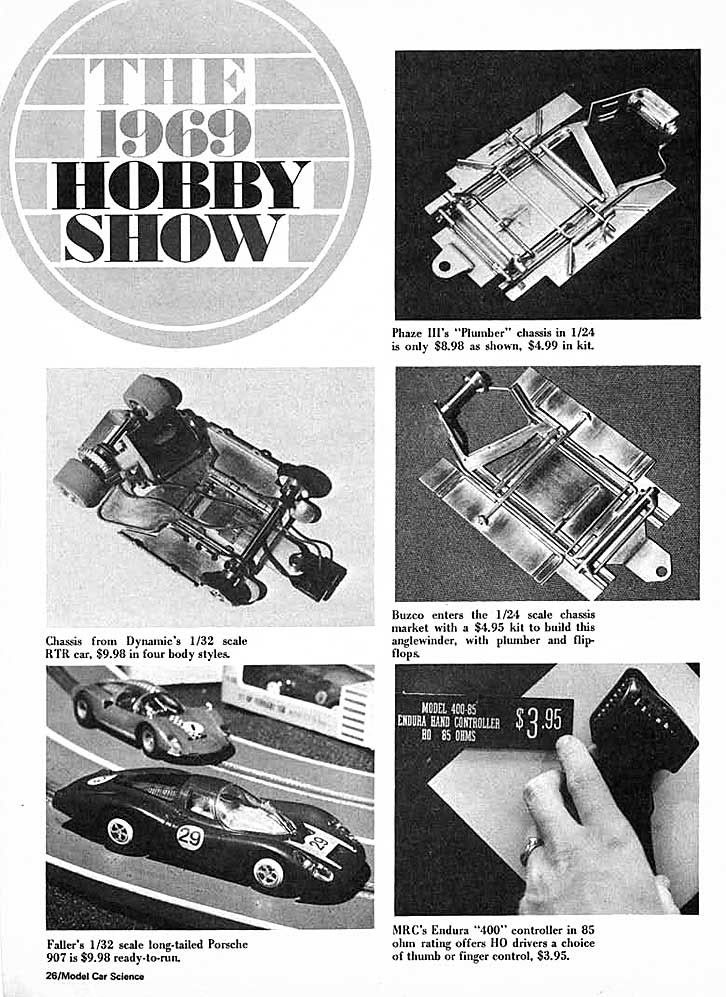
Car Model, July 1969: The Big Z in different iterations.
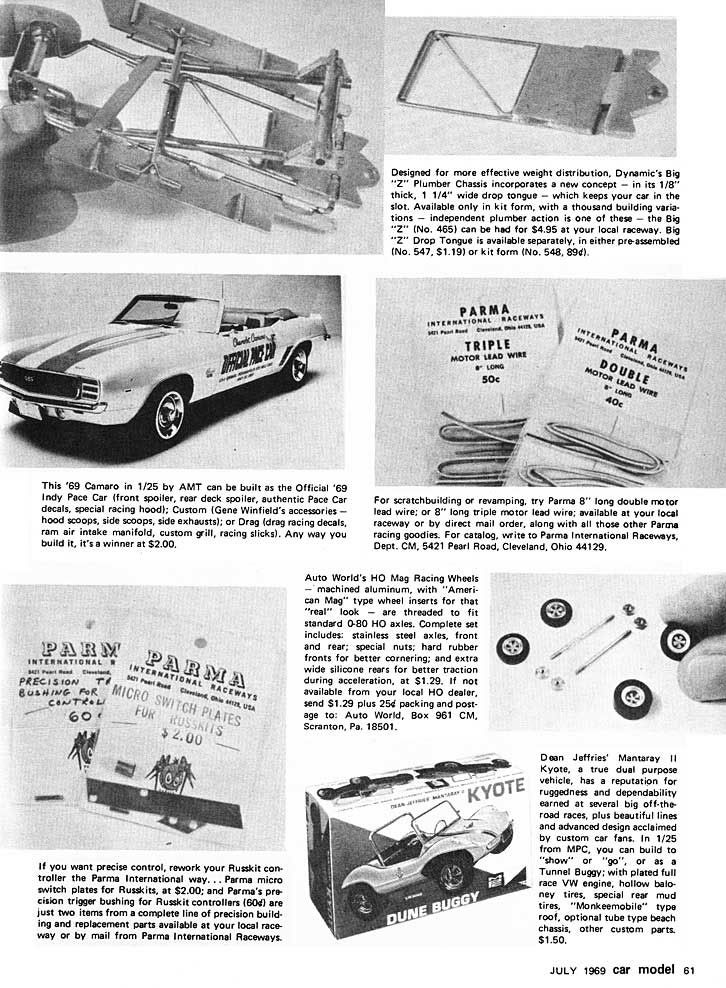
Model Car Science, August 1969: Manufacturer's preview: Dynamic's new line of parts.
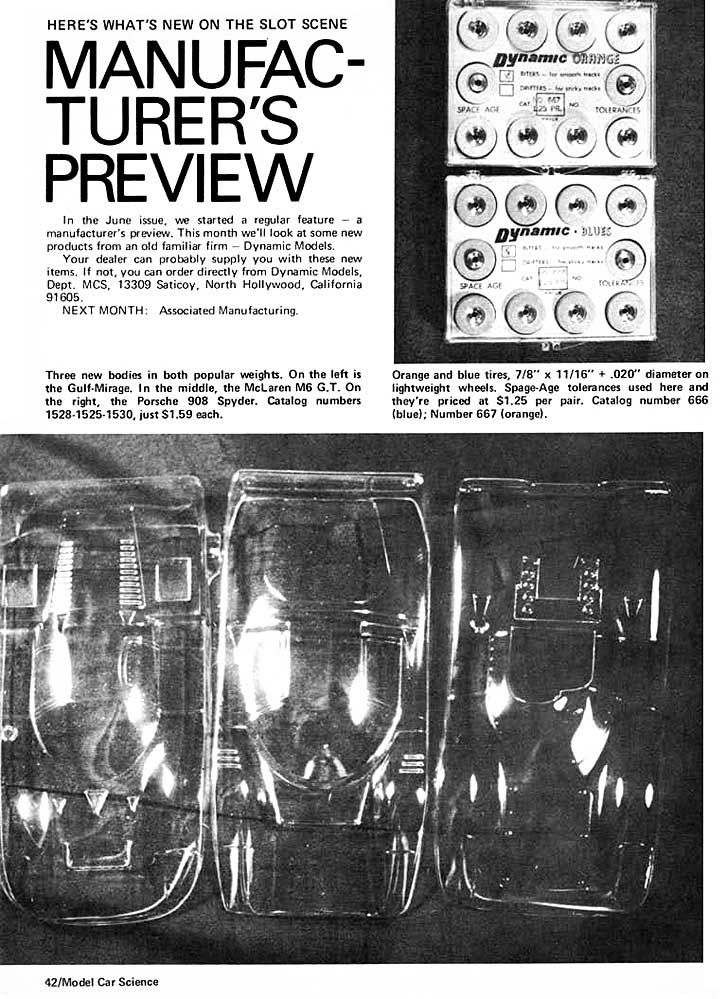
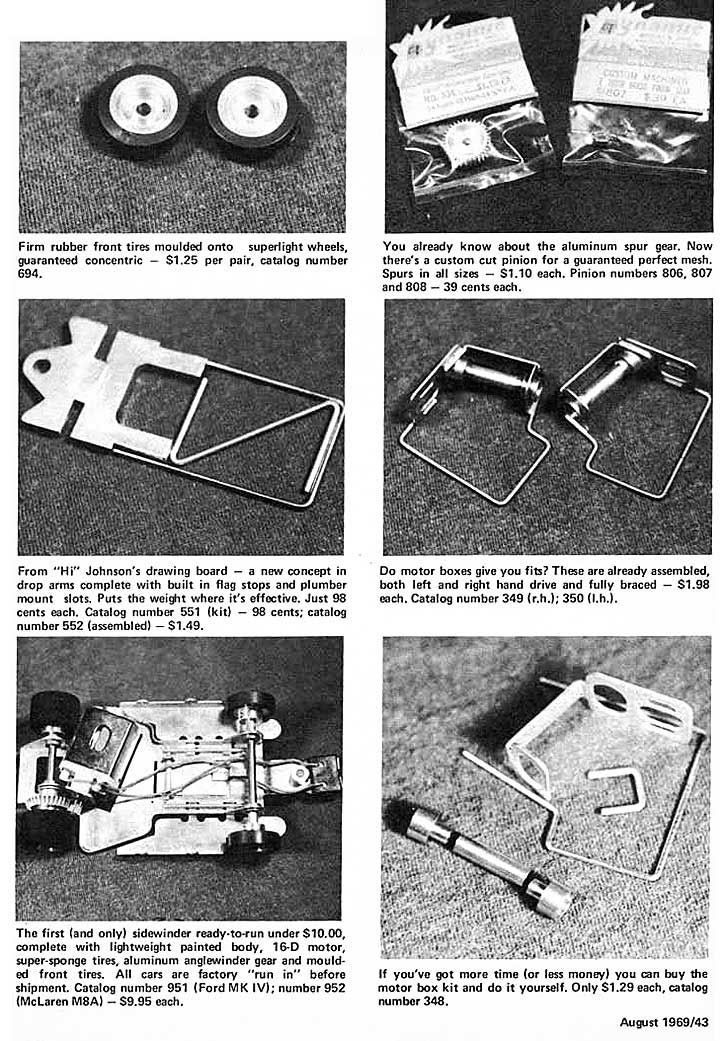
Car Model, September 1969: Bob Schleicher: Tuning and detailing the new stamped brass RTR car.


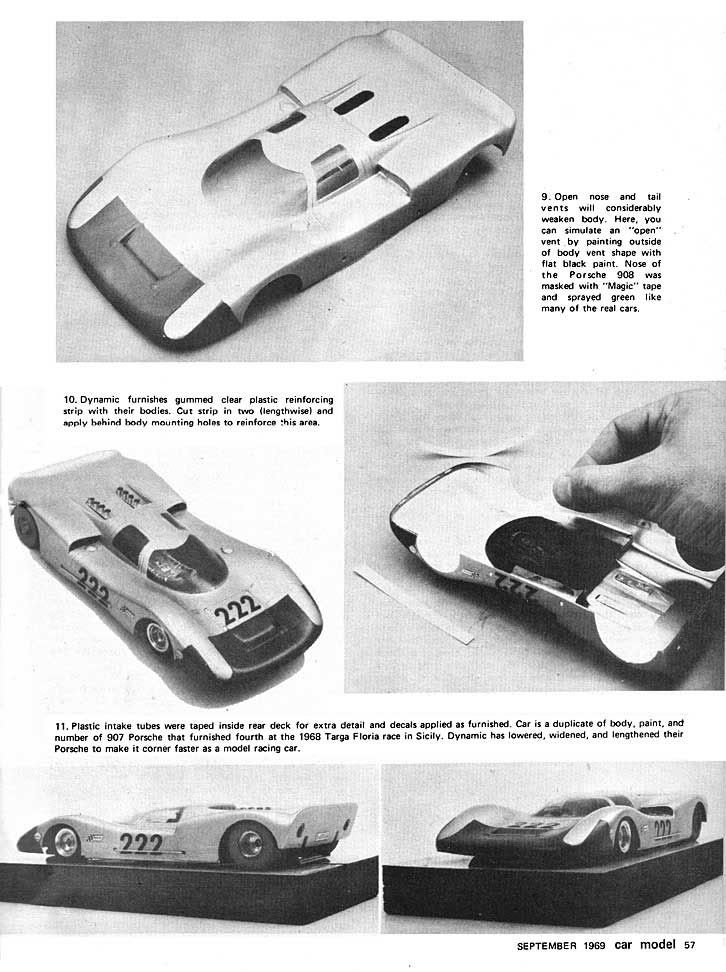
Model Car Science, September 1969: Mike Morrissey: Super-tuning the stamped brass chassis:


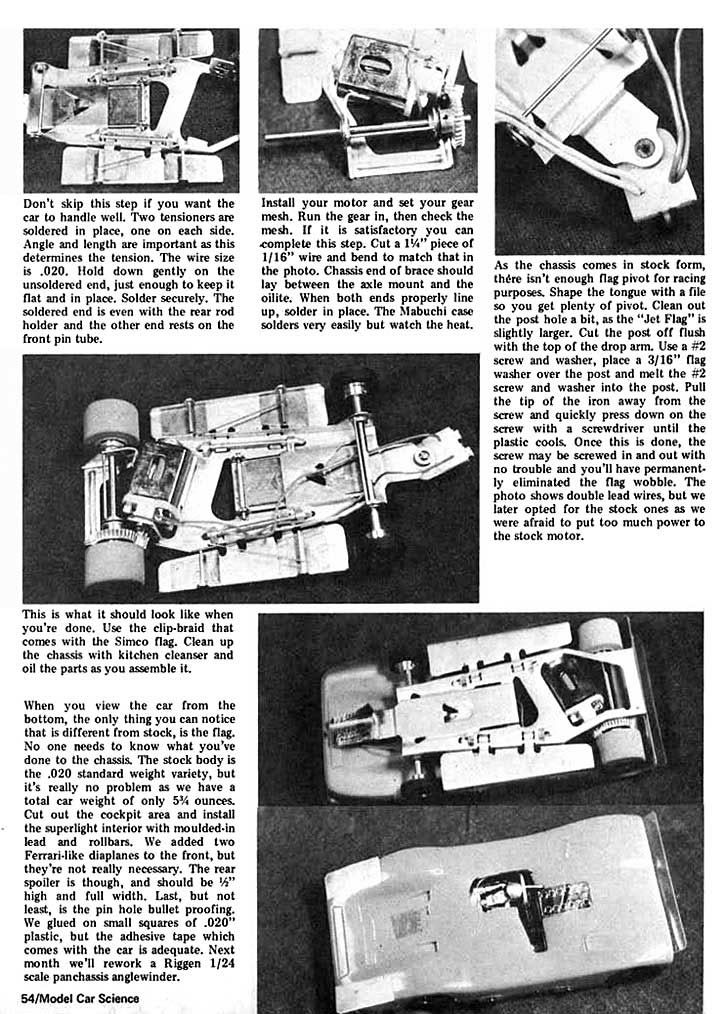
Model Car Science, October 1969: Building and tuning the stamped brass chassis — in 1/32.
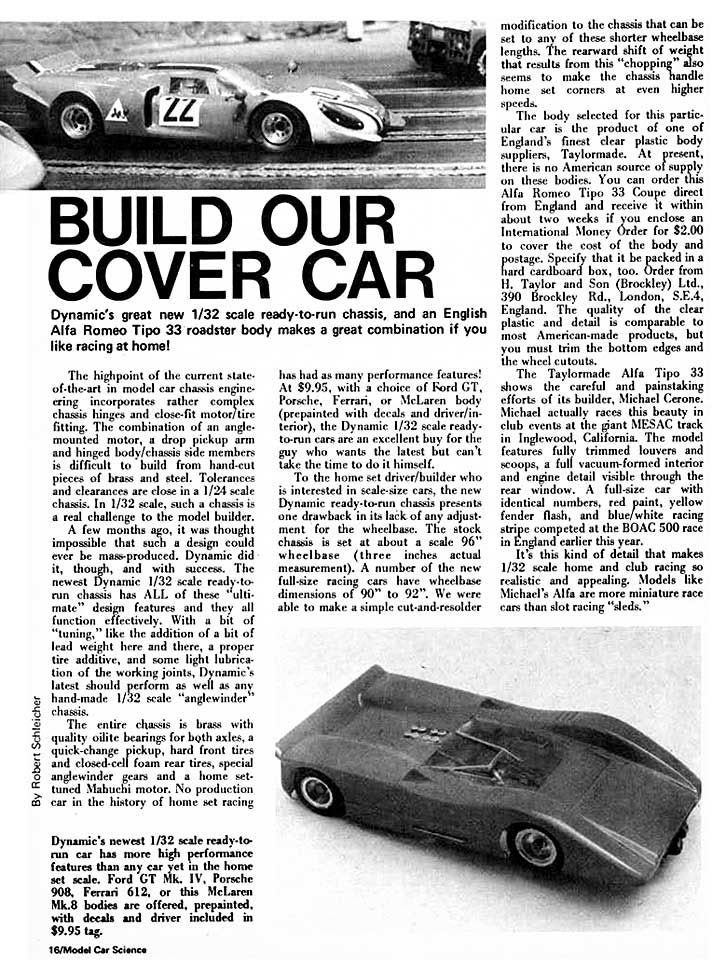
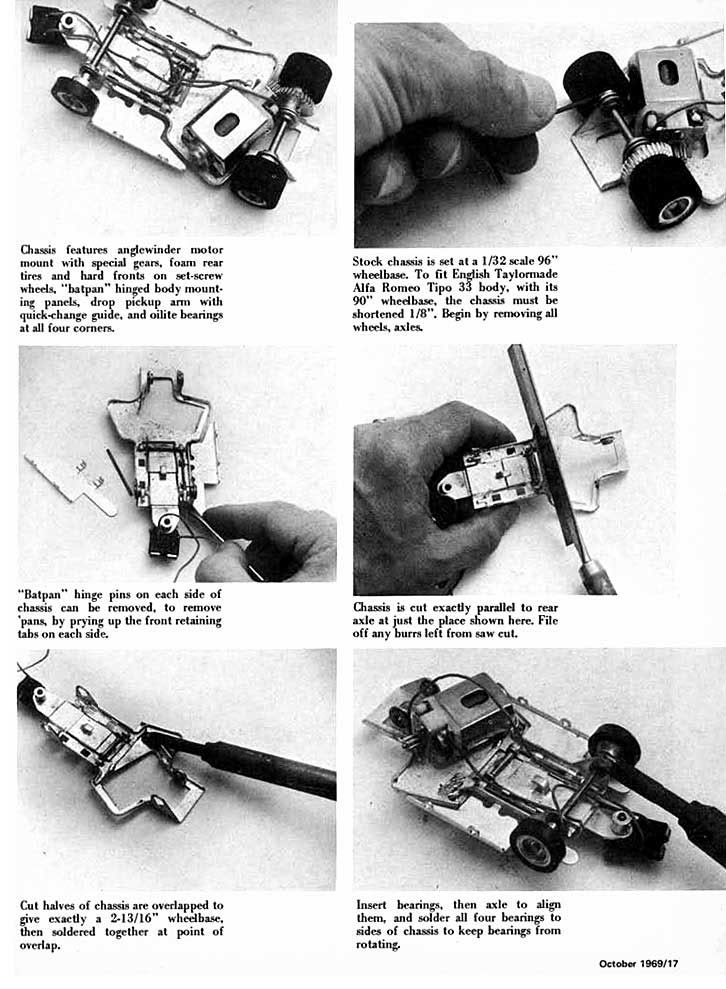
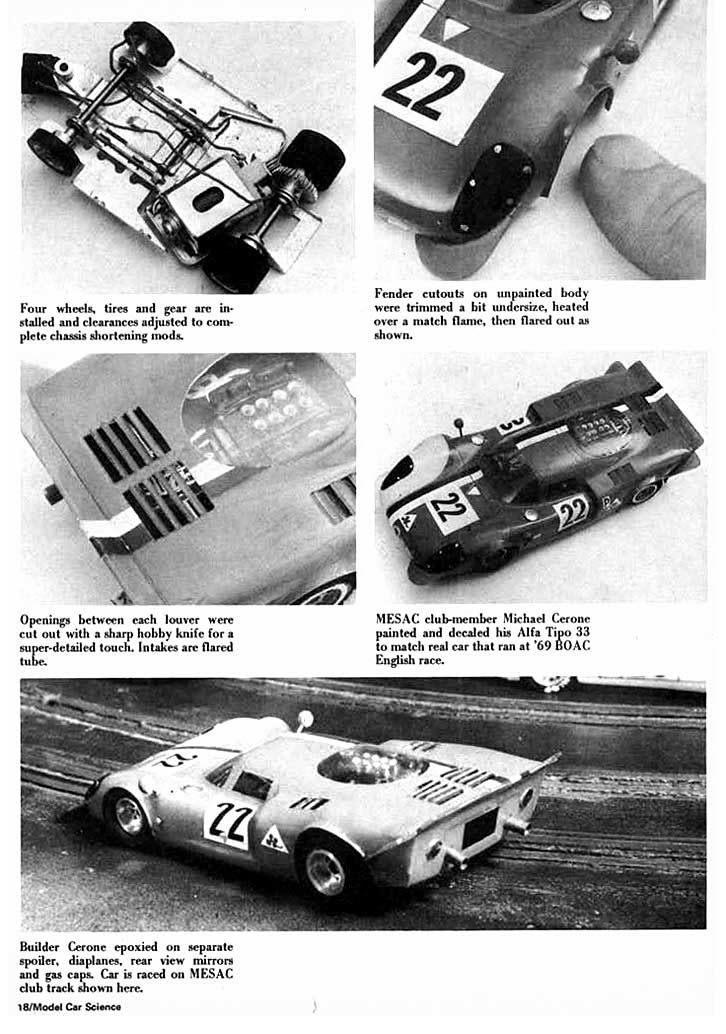
[To be continued...]
Overseas Observer
#57

Posted 27 October 2010 - 05:07 PM
January 1970, Car Model: This ProFormance Chaparral 2H ad is the last we'll ever see from Dynamic in the once dominating 1/24 scale in slot car racing.
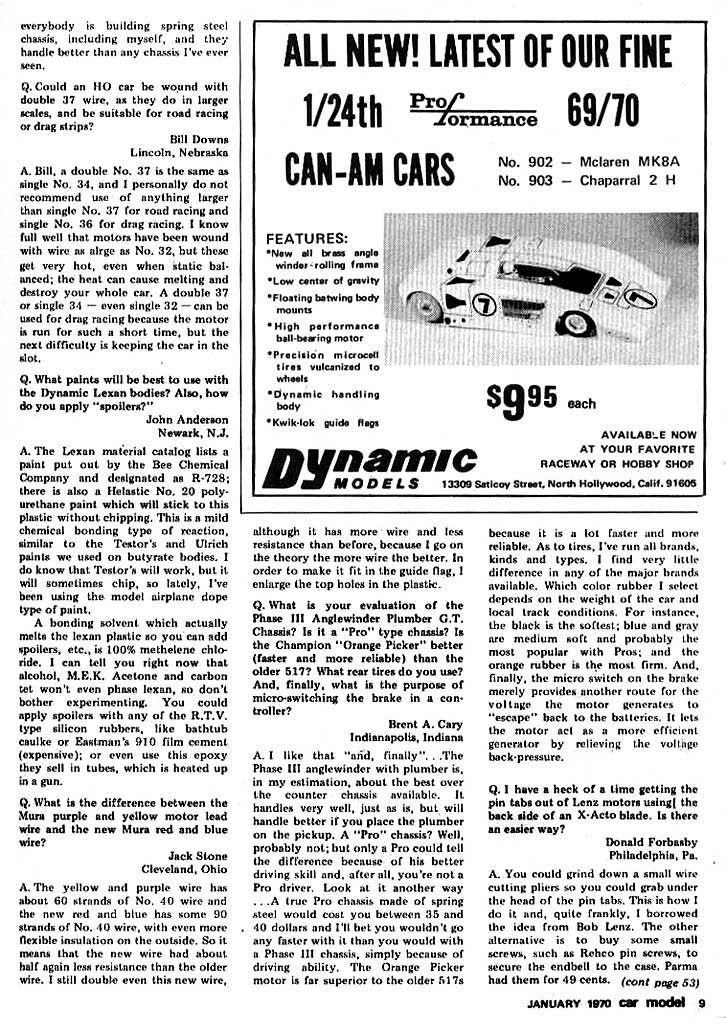
February 1970, Car Model: Dynamic breaks the R/C race car barrier. The company's first offering for the new era of model car racing.
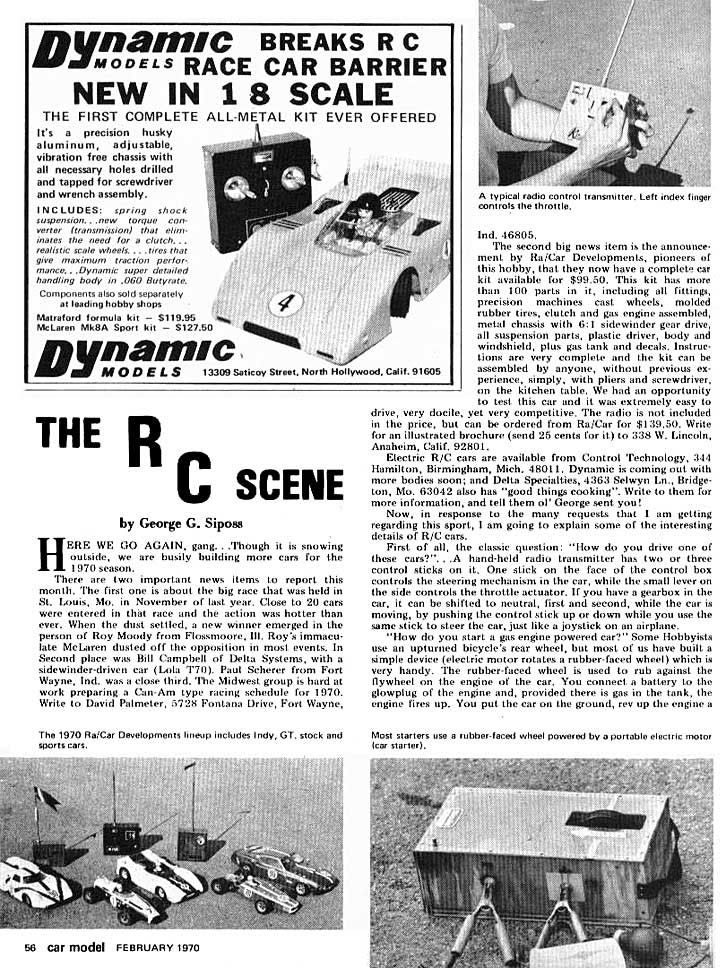
March 1970, Car Model: The Dynamic R/C chassis is designed to eliminate vibrations and harmonics.
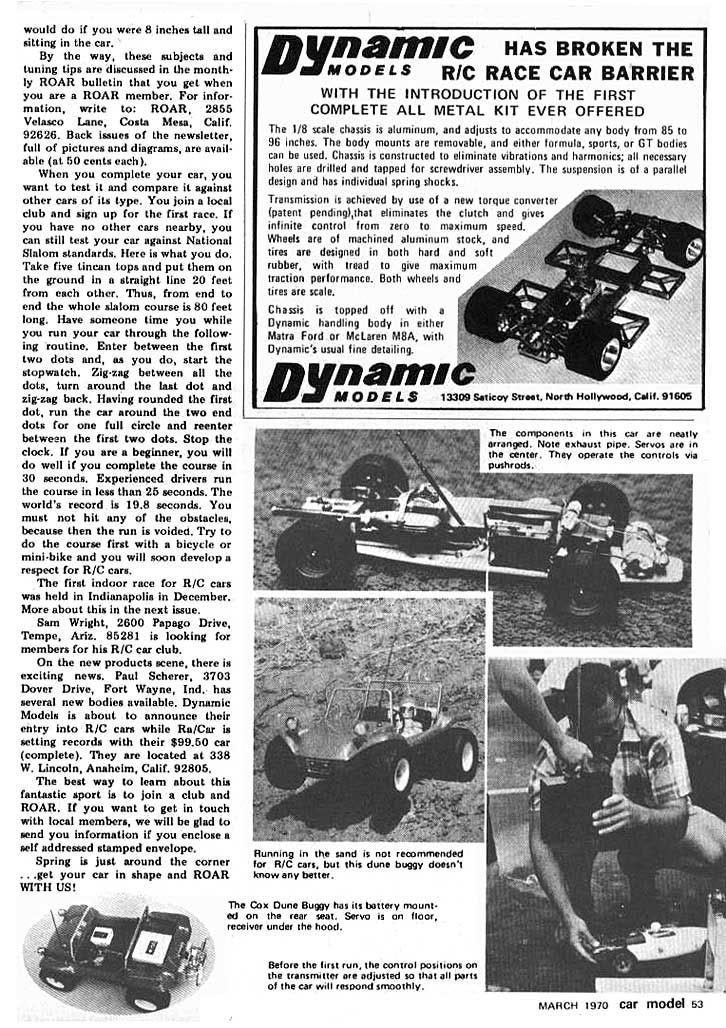
April 1970, Car Model: Same ad as March, with added info: Engine and radio is NOT included...
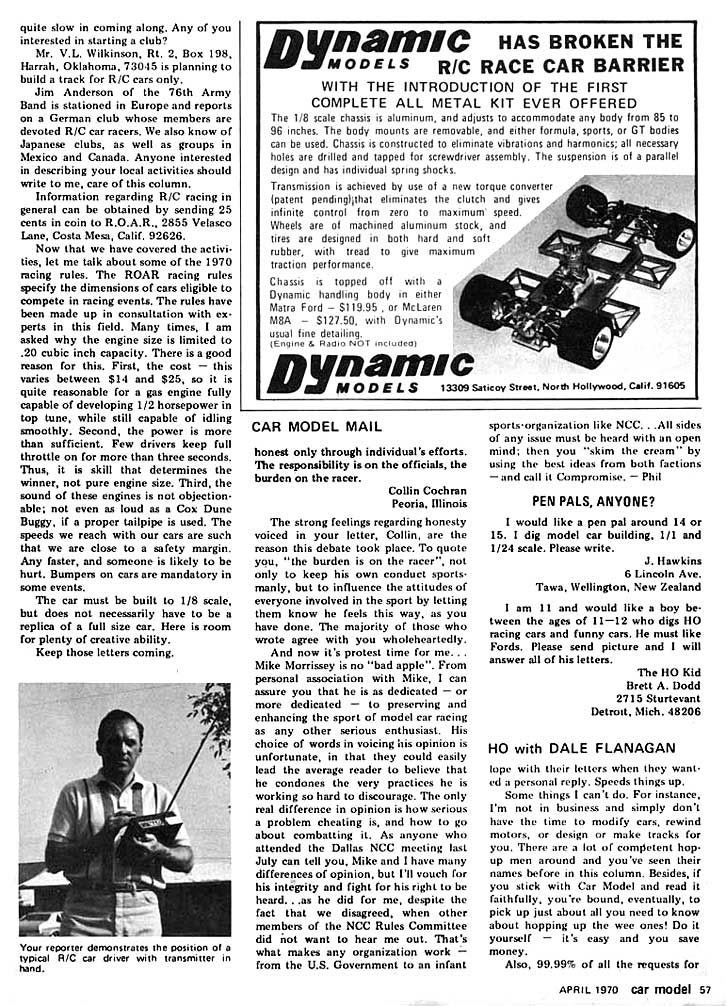
May 1970, Car Model: No ad, but an editorial flash on the new course of Dynamic: Gas-powered R/C racing.
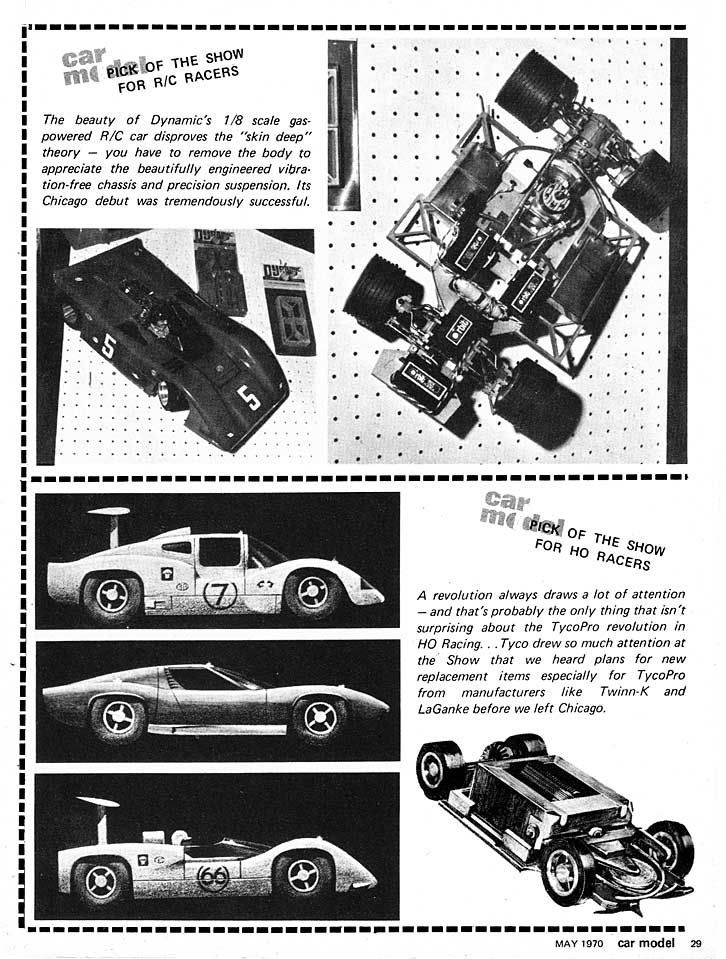
August 1970, Car Model: Dynamic R/C is in a class by itself. Same ad also in October and November issues of CM.
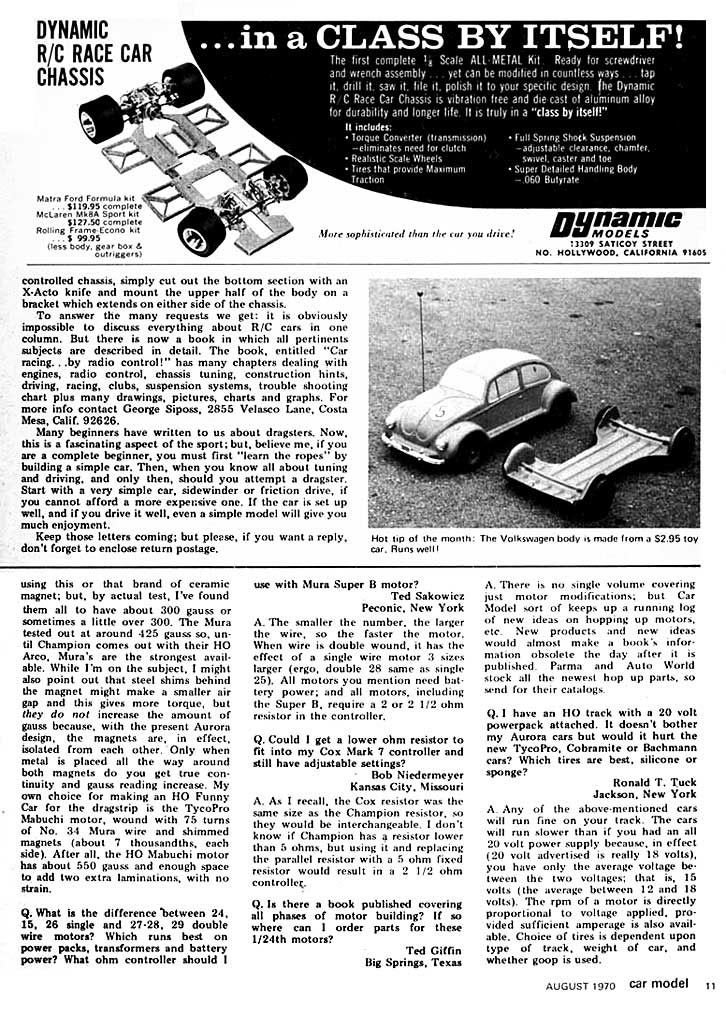
September 1970, Car Model: An ad with a different view of Dynamic.
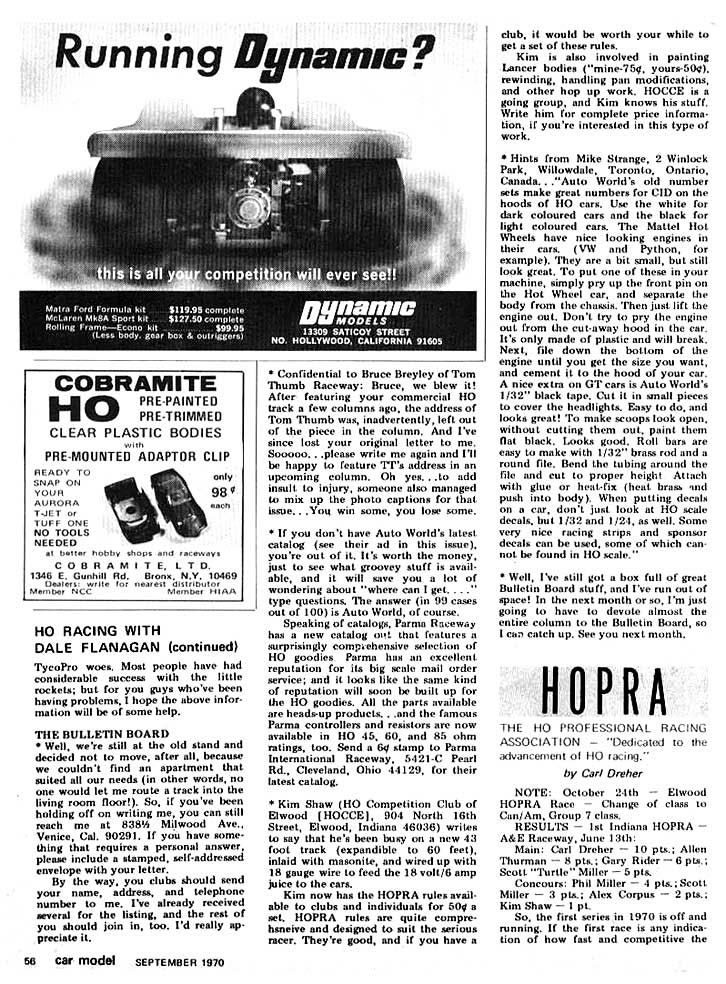
November 1970, Model Car Science: The only ad from Dynamic in MCS for the year. R/C, of course.
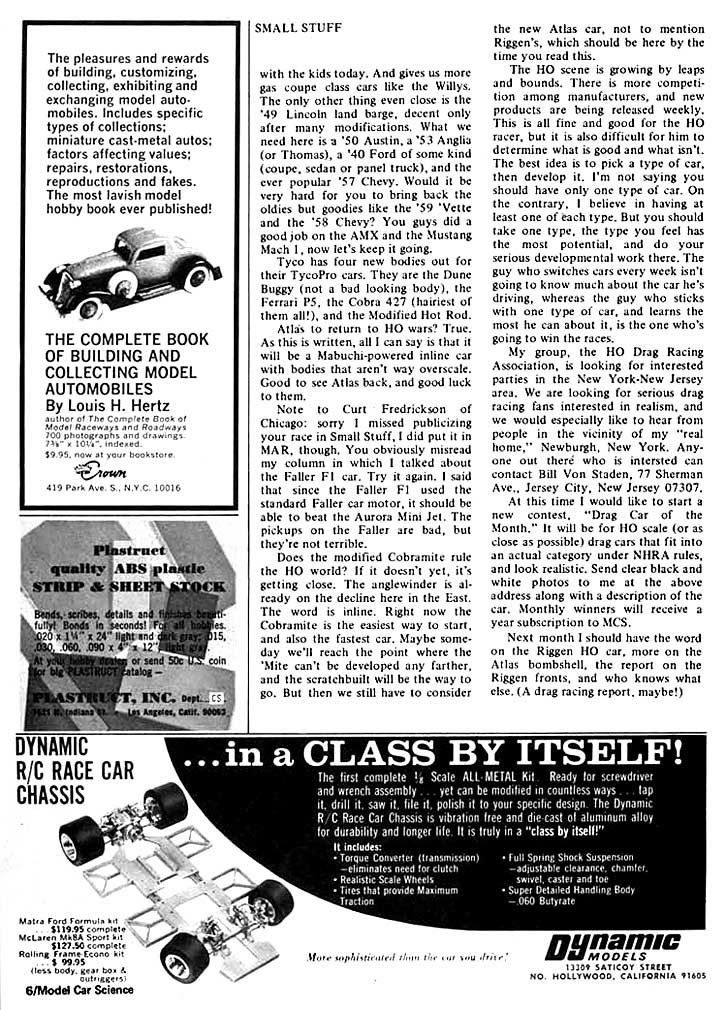
December 1970, Car Model: Completely new cars. A rigid and rugged new chassis plus two new bodies ends the first R/C year for Dynamic.
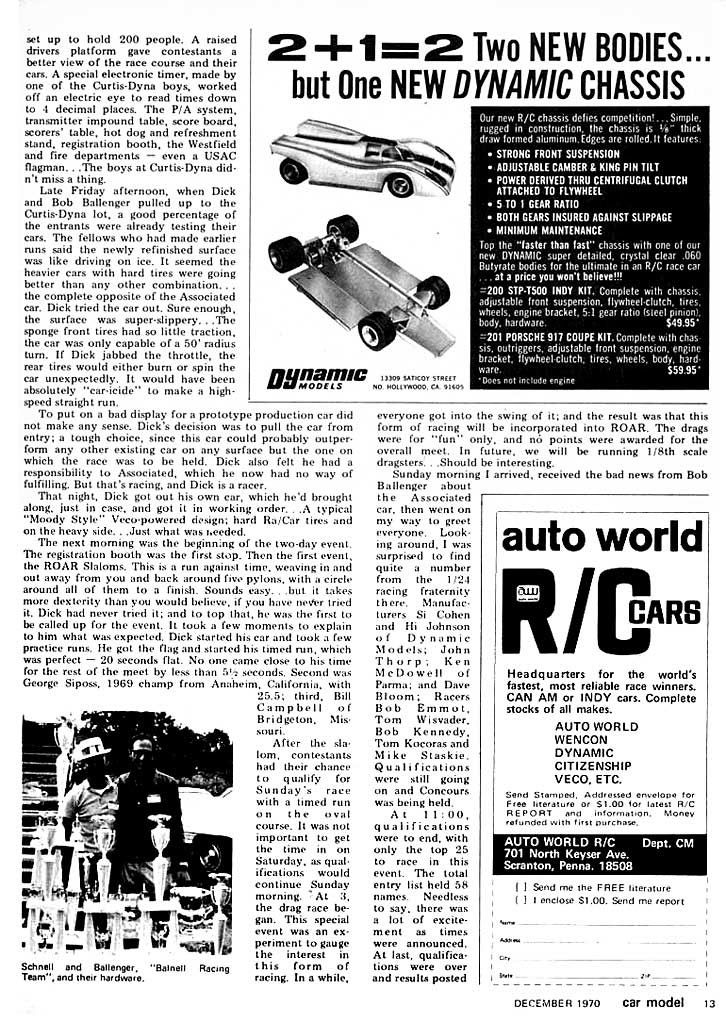
[To be continued...]
Overseas Observer
#58

Posted 28 October 2010 - 01:48 AM
These bodies were in fact the AMT slot kit bodies from 1965 but the Cobra was cast in grey plastic, and I have only seen red Mustangs but there may be other colors, too.
I was going to build the Cobra up with a Dynamic chassis but the original front body post had been designed to fit the AMT aluminum ladder type chassis and I realized I would have too cut it off to get the Dynamic chassis to fit right, so instead I scrounged up a used AMT chassis. I converted the motor to a 36D (from the original grey 35R) which I had seen in one of the Mustangs which appeared to have been converted to a Green Hornet 36D with a factory-made modified motor mount. I never noticed this conversion part listed anywhere.
Gb
#59

Posted 29 October 2010 - 06:33 PM
but 1971 also debuts the the smallest Dynamic cars ever — the DynaBrute in the still popular slot racing tiny scale H0.
The DynaBrute was, and still is, the only production angle-winder car in H0, which also made it a bit larger than its contemporary
counterparts from the brass era i H0 racing, Riggen and CobraMite. The DynaBrute was an odd parenthesis in the history of H0
slot car racing, not very successful and also with no followers. Nevertheless, the DynaBrute is a coveted collector's piece today.
January & February 1971, Car Model: Boosting the new R/C car design with a simple and rugged aluminum pan chassis.
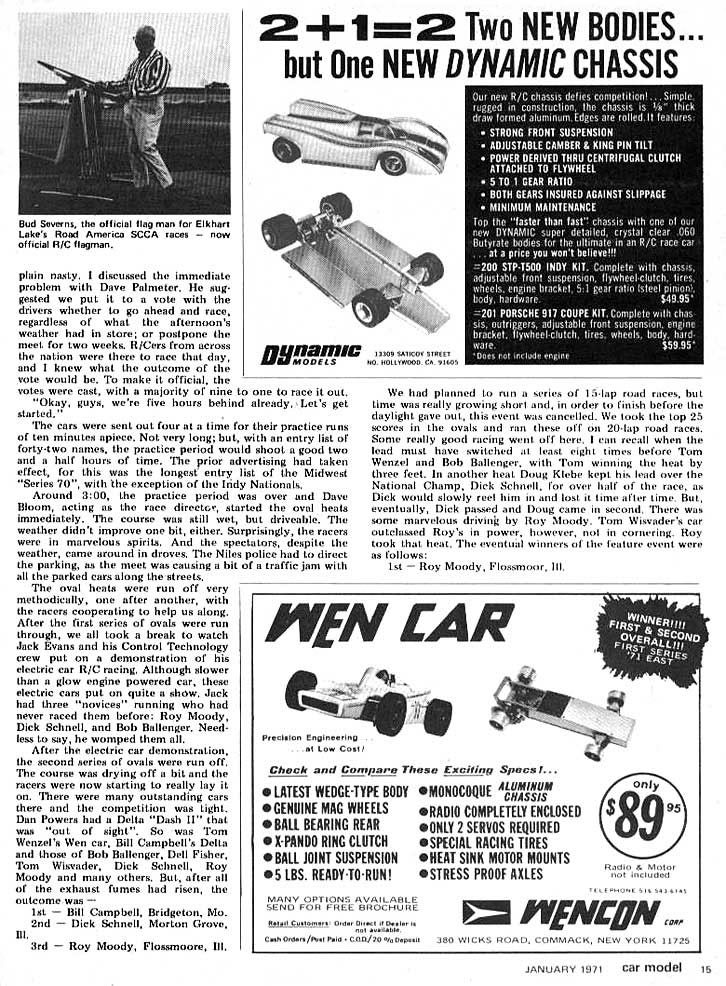
March & April 1971, Model Car Science and Car Model, May 1971, Car Model only: The DynaBrute debuts. Same ad in both mags.
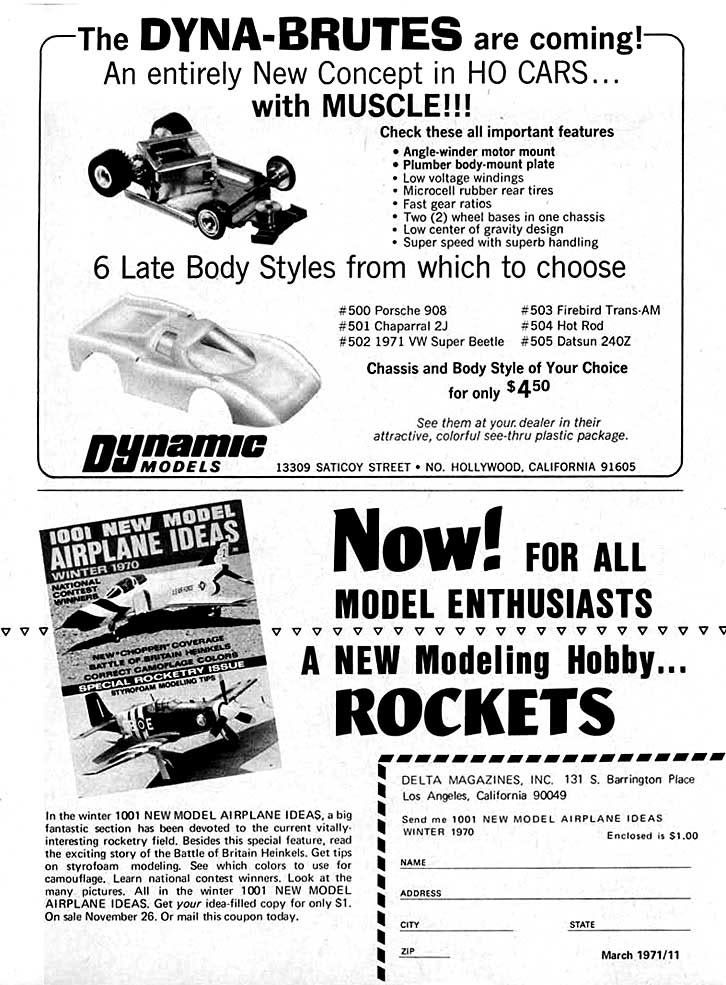
June 1971, Car Model: Back to the R/C line, and five good reasons to race with Dynamic.
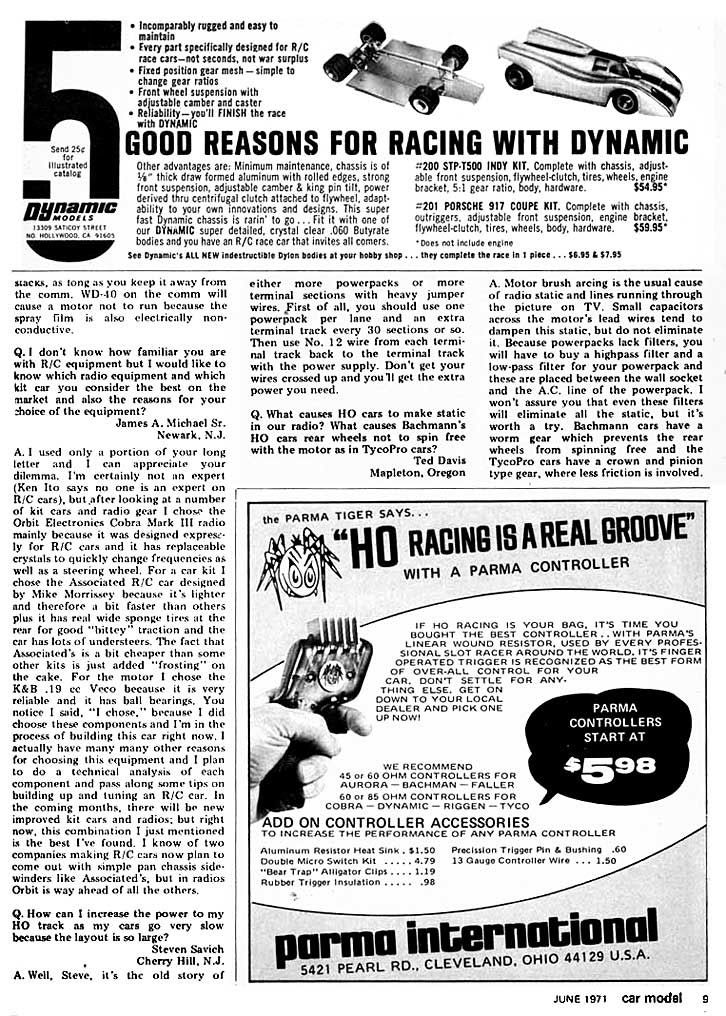
July 1971, Car Model: A special one-off ad: Promo for glow plugs in R/C gas motors.
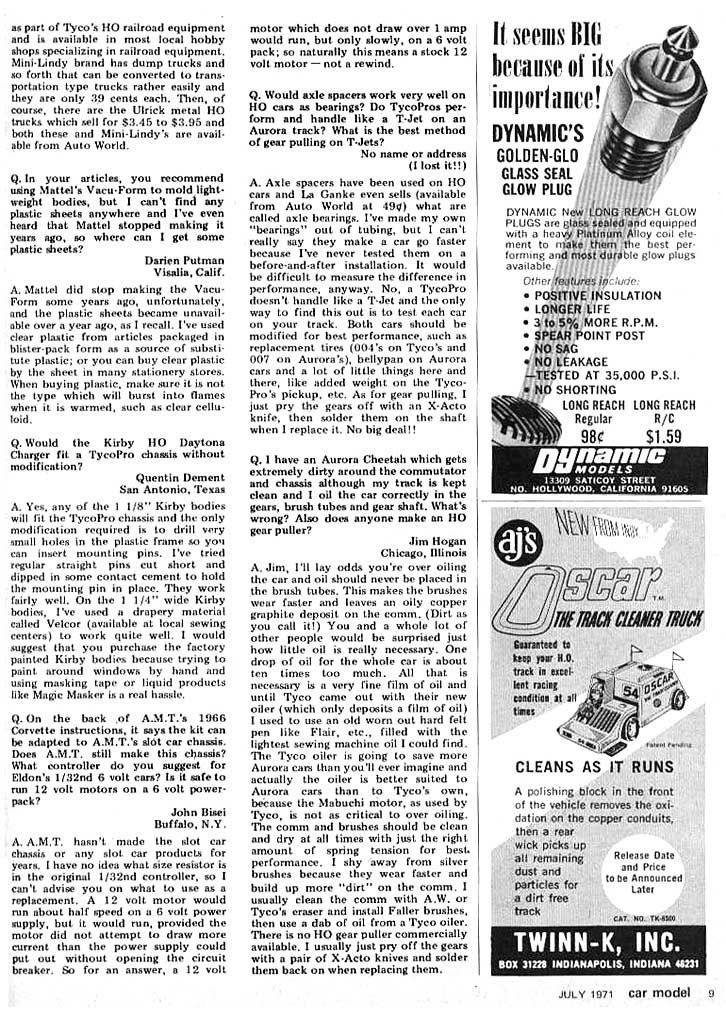
August, September, October and November 1971, Car Model:
Back to the DynaBrute again. Smaller ads, same in every issue. And only in CM, no ads in MCS.
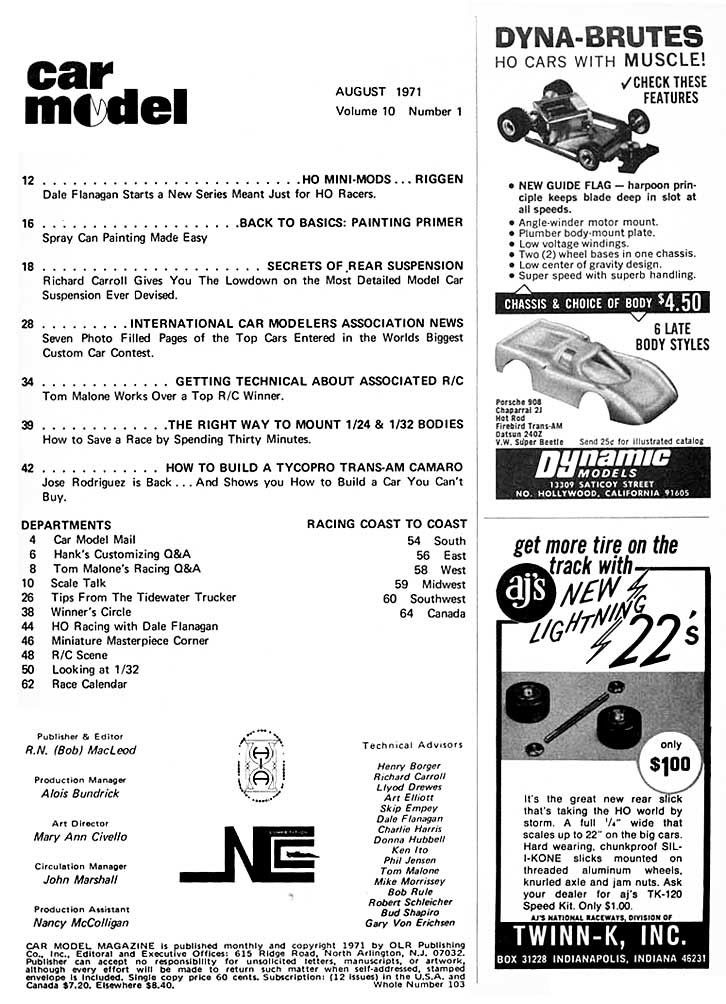
December 1971, Model Car Science and Car Model: Bigger ads again for the Dynabrute. Also introducing new bodies.

[To be continued...]
Overseas Observer
#60

Posted 30 October 2010 - 04:13 PM
But his didn't pay off in editorial space in CM. On the other hand, Model Car Science dedicated a lot more pages to Dynamic
products, even though the paid ads went somewhere else.
January 1971, Car Model: The new Dynamic R/C car with pan chassis is pre-viewed, as well as a heat sink for the motor.
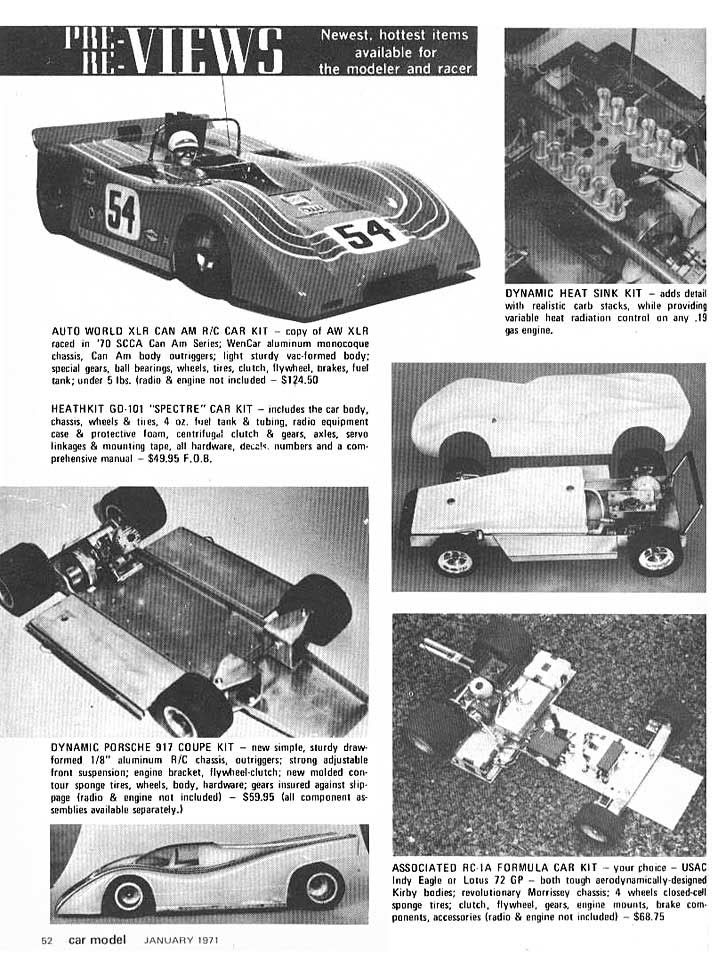
February 1971, Model Car Science: Four pages ”Basic tuning tips” for a Dynamic 1/32 stamped brass chassis car.

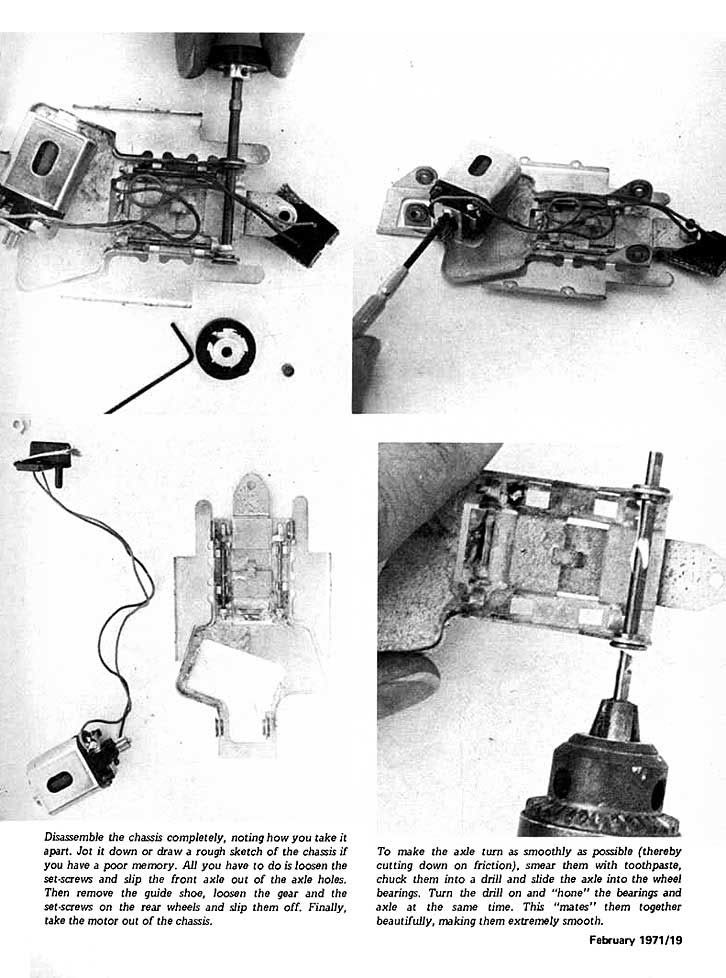
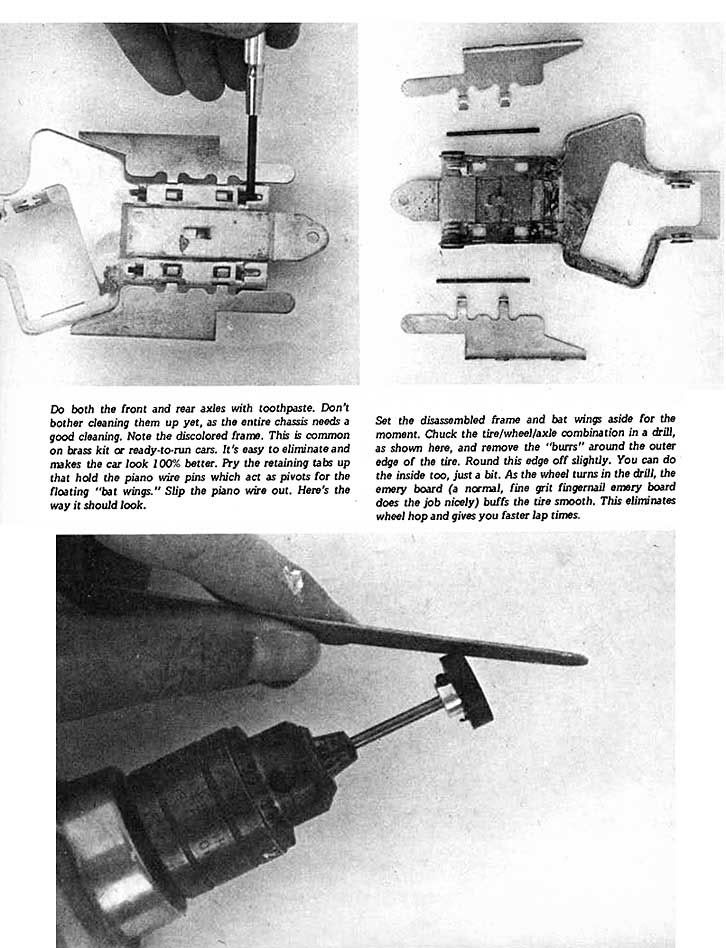

May1971, Car Model: The DynaBrute gets a bit of editorial space in CM, in a preview from the 1971 Hobby Show in Chicago.

May1971, Model Car Science: DynaBrute and the Dynamic R/C car tid bits from the Chicago Hobby Show and...

May1971, Model Car Science: ...also the first real in-detail presentation of the DynaBrute, a four page editorial in MCS.
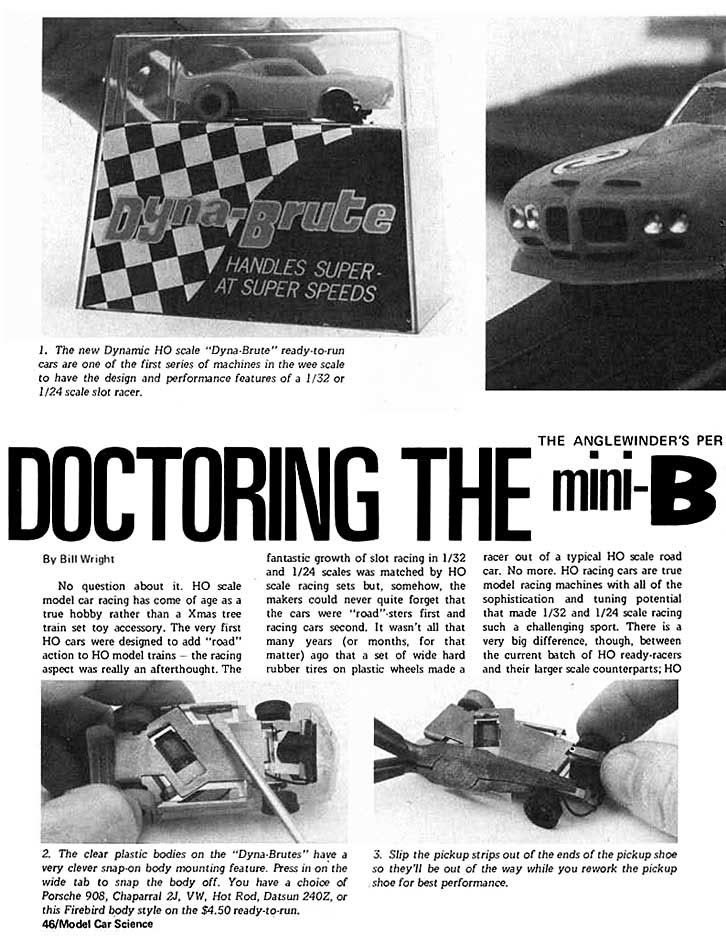
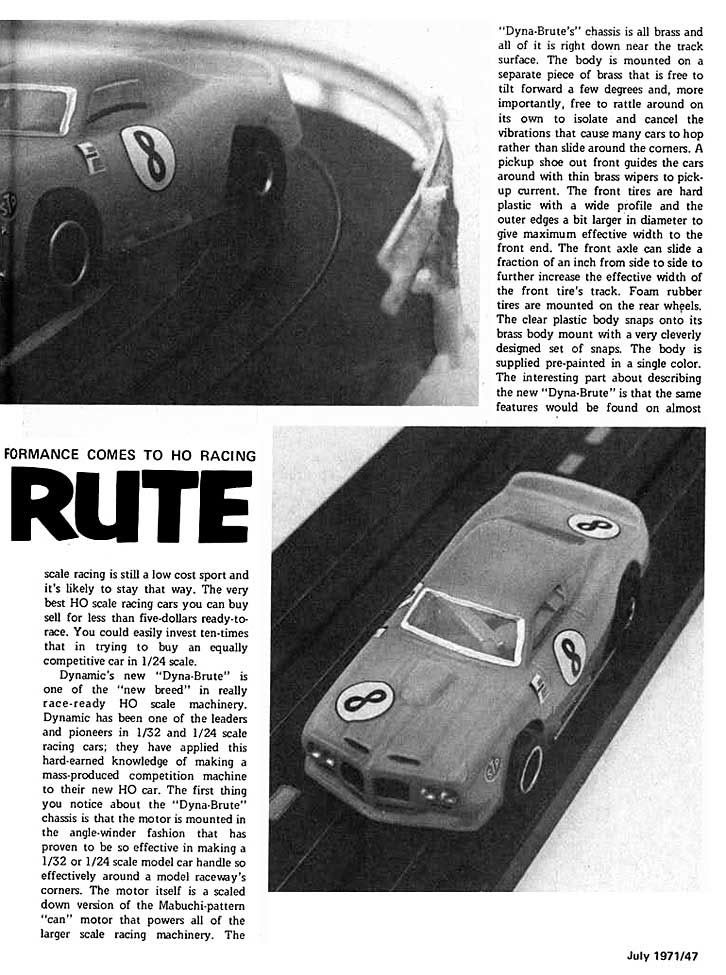
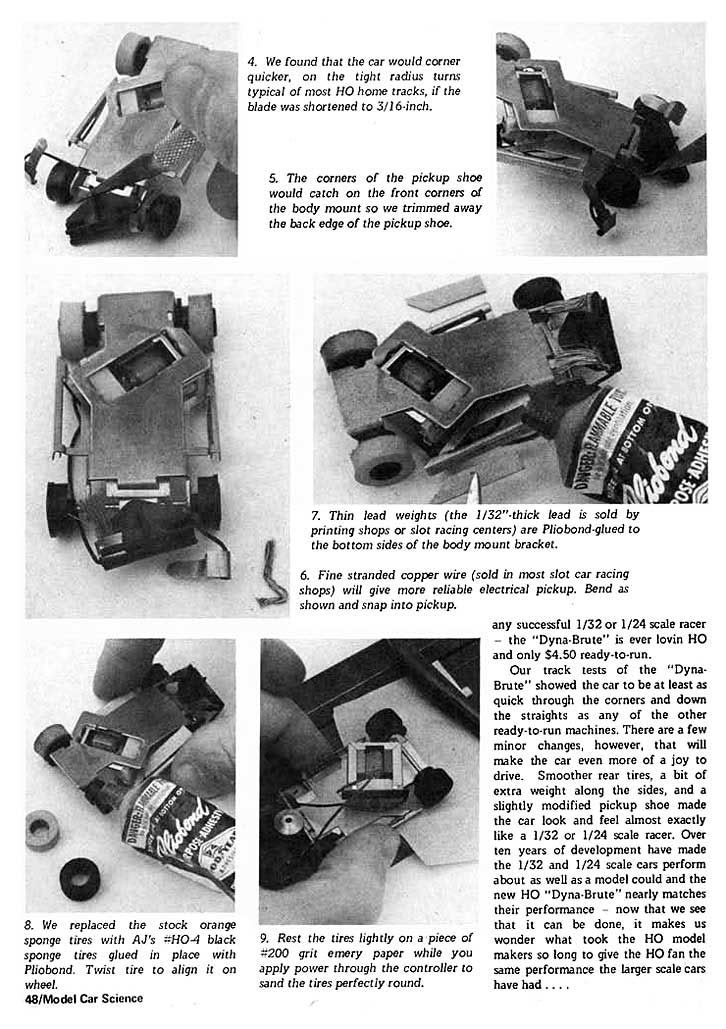
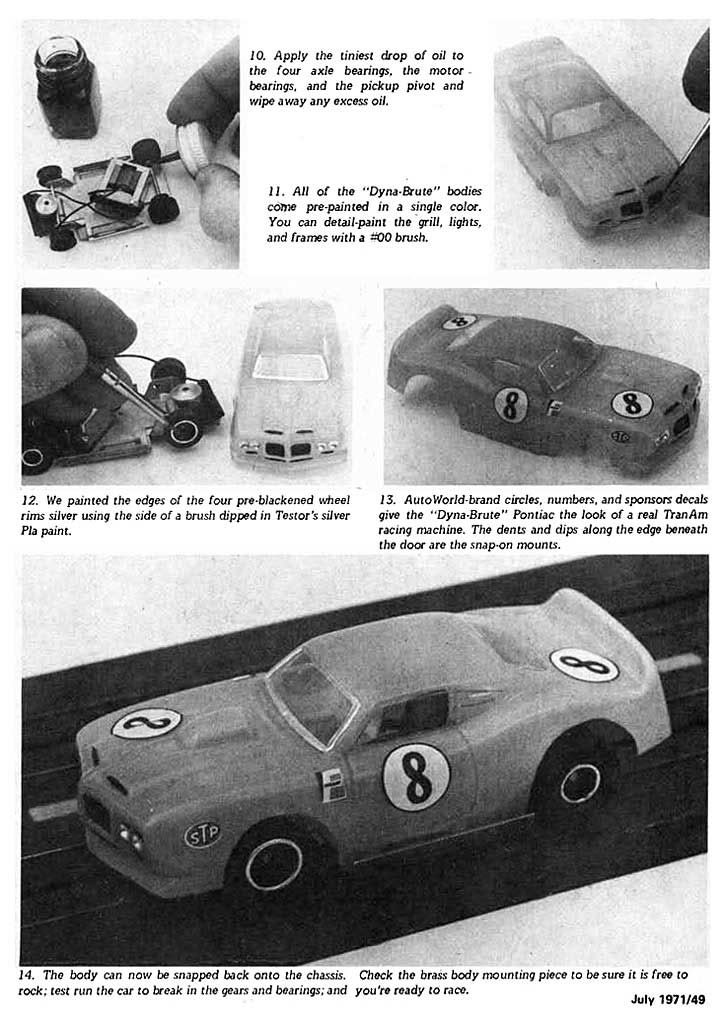
May1971, Model Car Science: The new Dynamic R/C pan is also ”feature car" this month in MCS. A three-page editorial by Gene Husting.
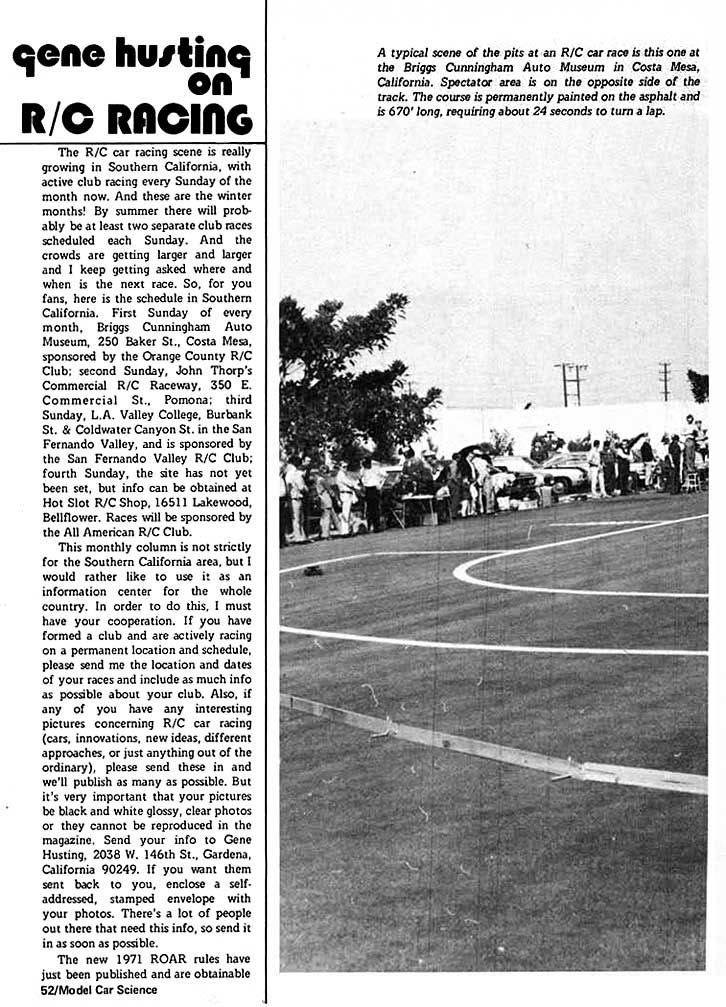
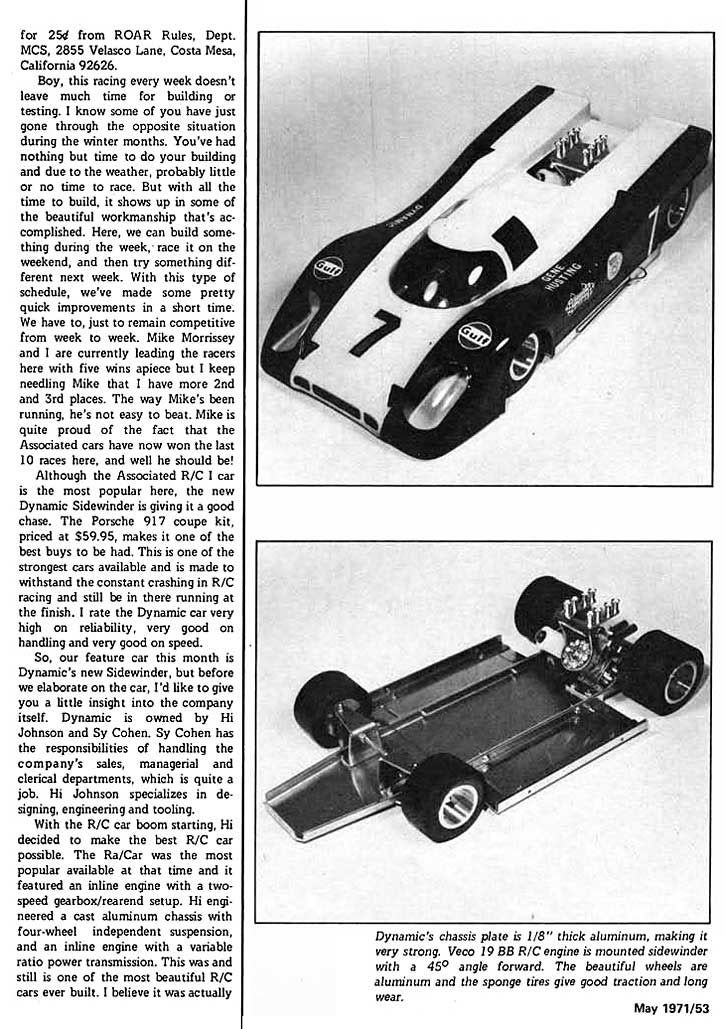

June1971, Car Model: The DynaBrute gets its 15 minutes of fame also in Car Model by H0 guru Dale Flanagan.
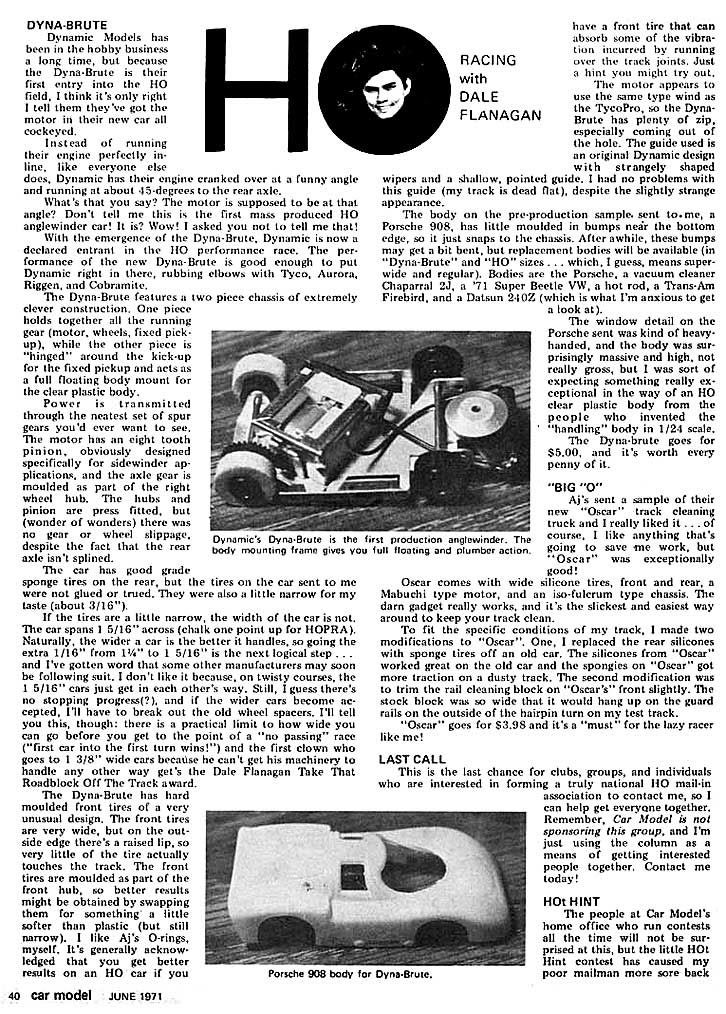
[To be continued...]
Overseas Observer
#61

Posted 31 October 2010 - 06:50 AM
Thanks this was alot work for this topic i appreciate Time & effort thats what makes SLOT BLOG great. Hope some of the other HO guys get to read this. I am looking for a Parma HO plumber chassis if anyonne has let me know.
Thanks John
#62

Posted 31 October 2010 - 06:43 PM
has been intensly present in every corner of the hobby and all over the diversified game field: 1/24, 1/32, H0, and R/C.
Before, during and after the slot slot racing craze in the mid to late 1960s. And is now vanishing slowly into the sunset...
January 1971, Car Model: The DynaBrute is now new and improved. Same ad also in CM in February.
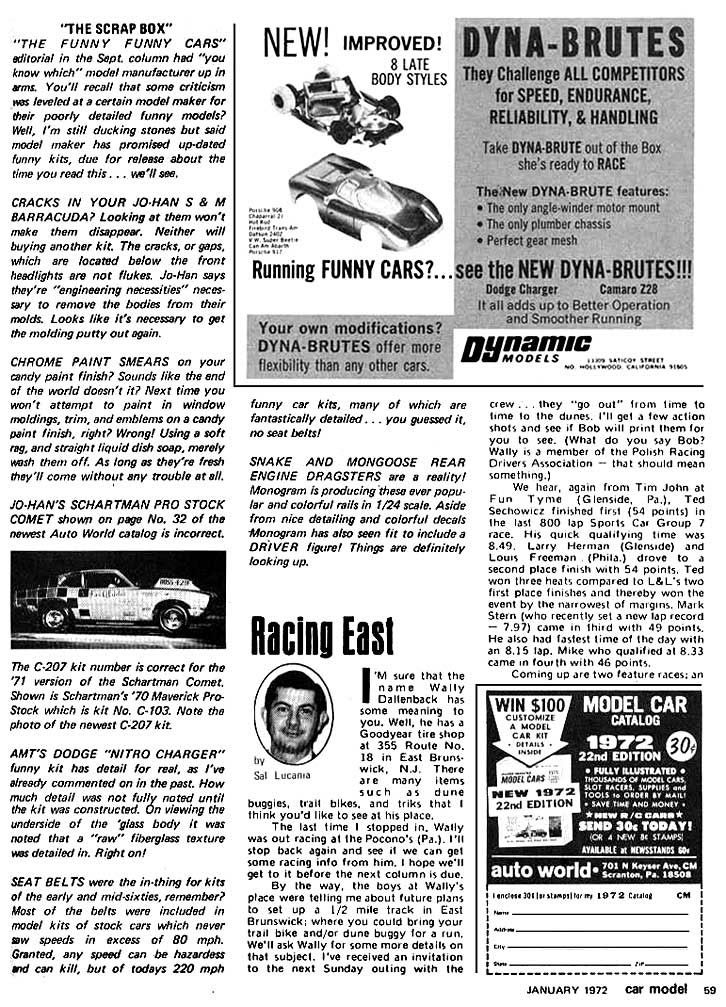
January 1971, Car Model: Almost everything you need to know about the Dynamic R/C line. Three pages.
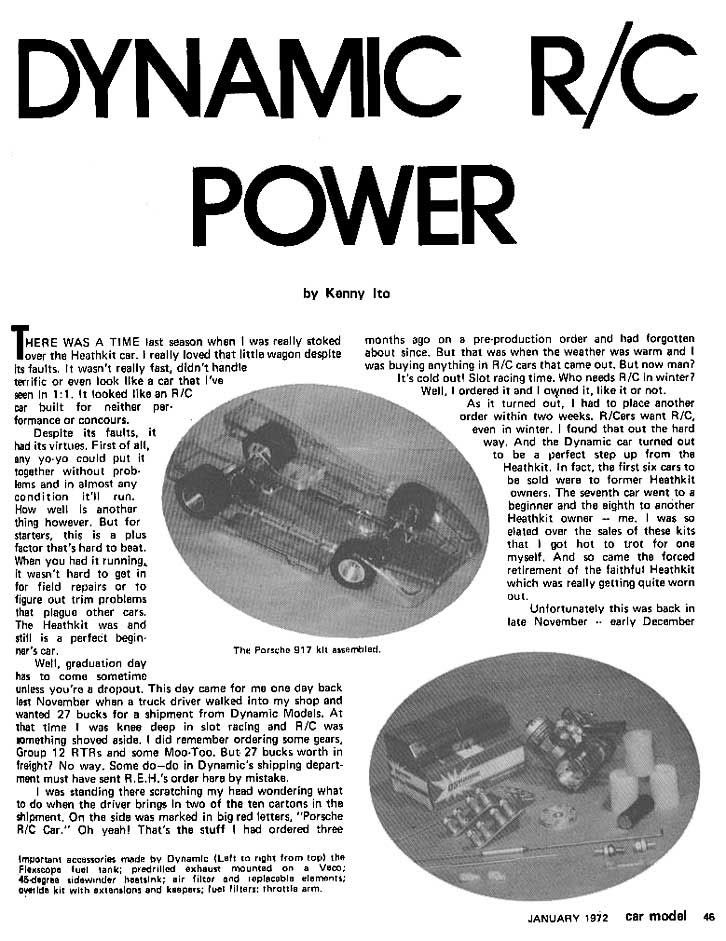
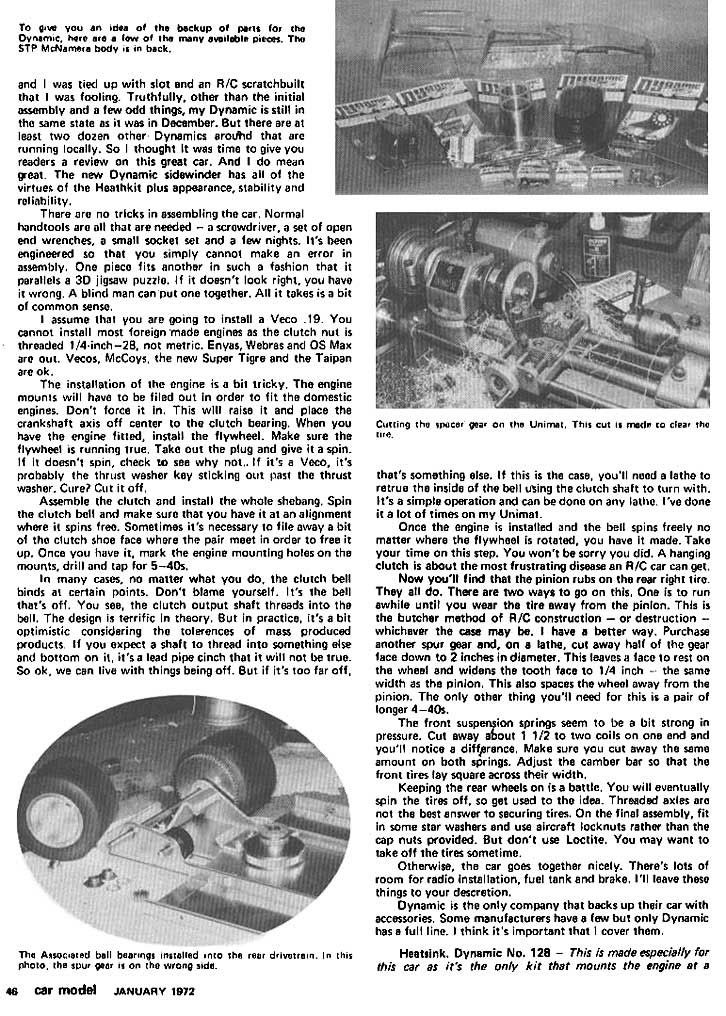
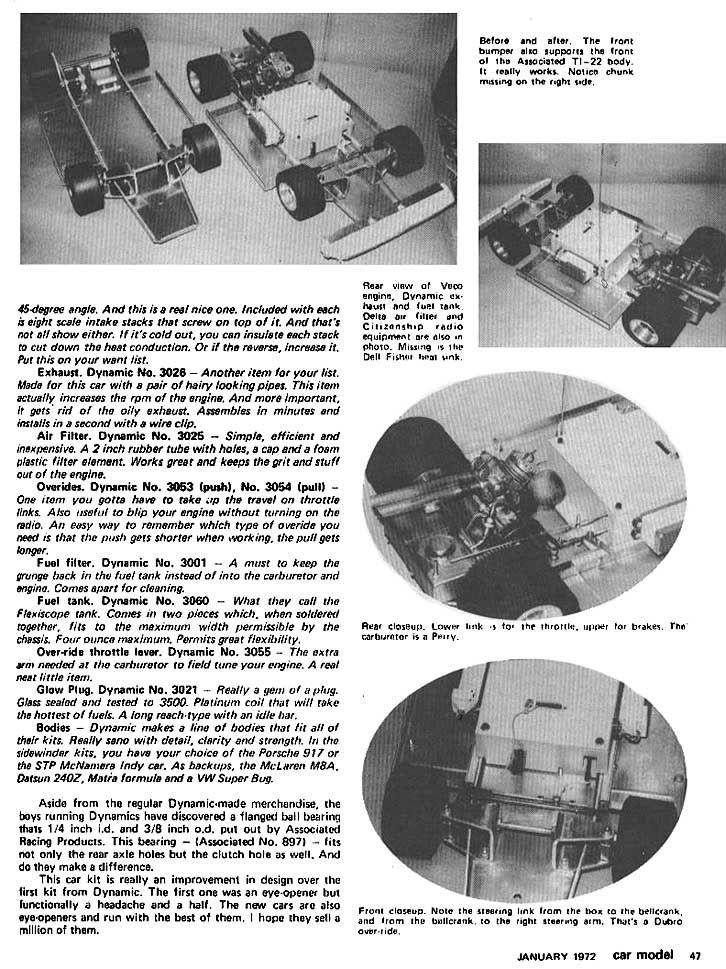
February 1971, Car Model: Cheap and simple mods to make the DynaBrute a winner for a quarter and a washer.
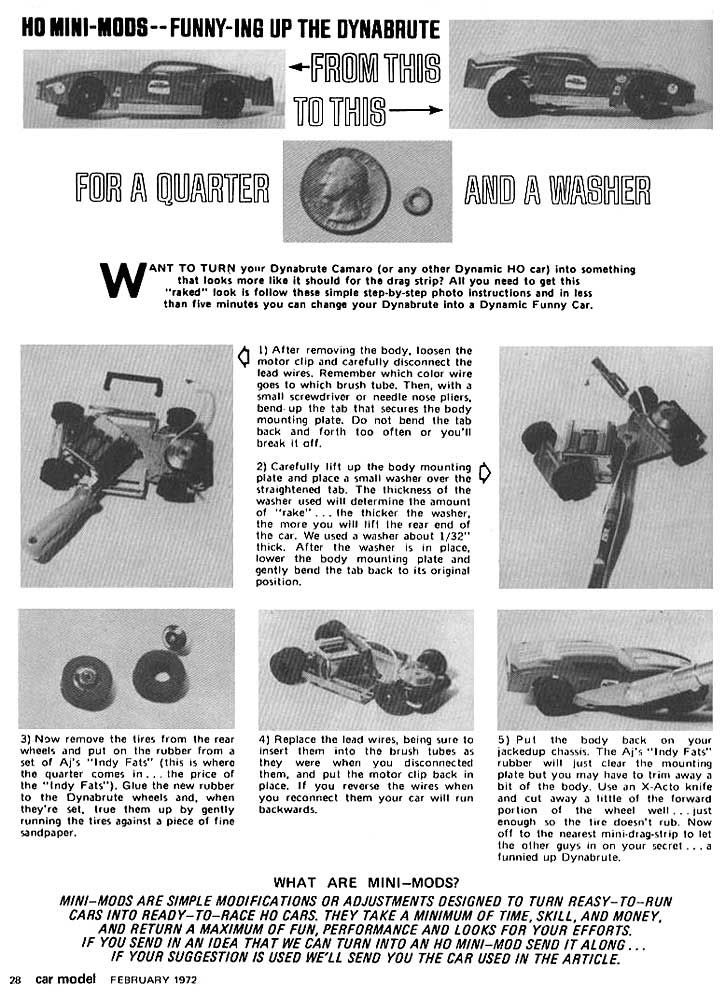
March 1971, Model Car Science: Unique scratch project: DynaBrute + Dynabrute = SuperBrute with twin AW motors.

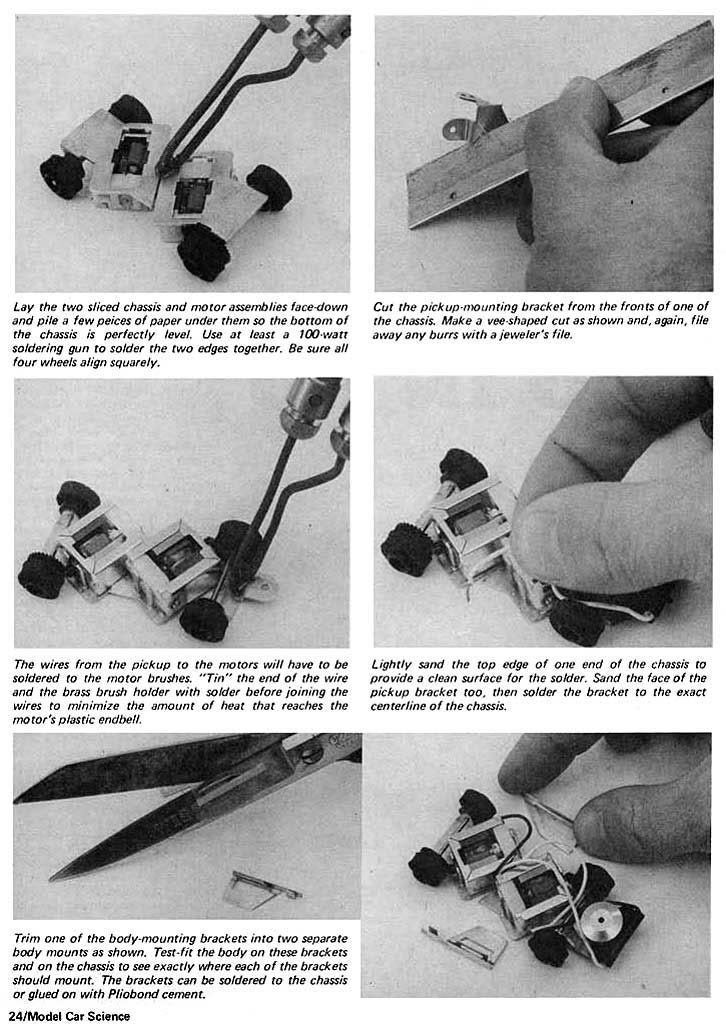
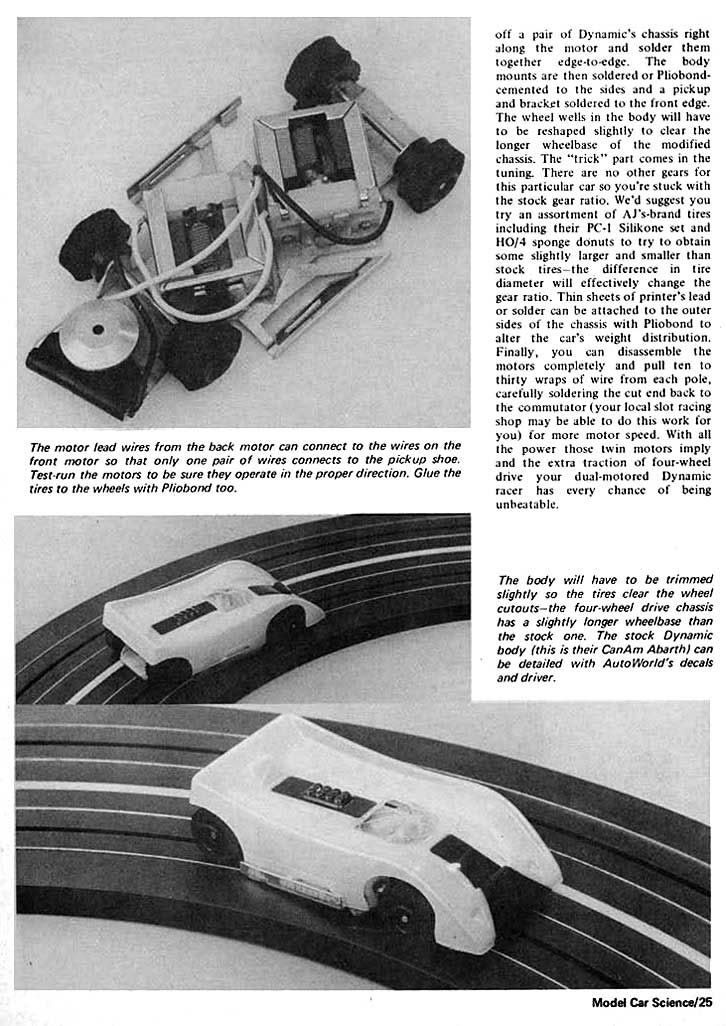
April 1971, Car Model: At last! A new body concept after "handling": Aero-Dynamic! The last gasp in 1/24.
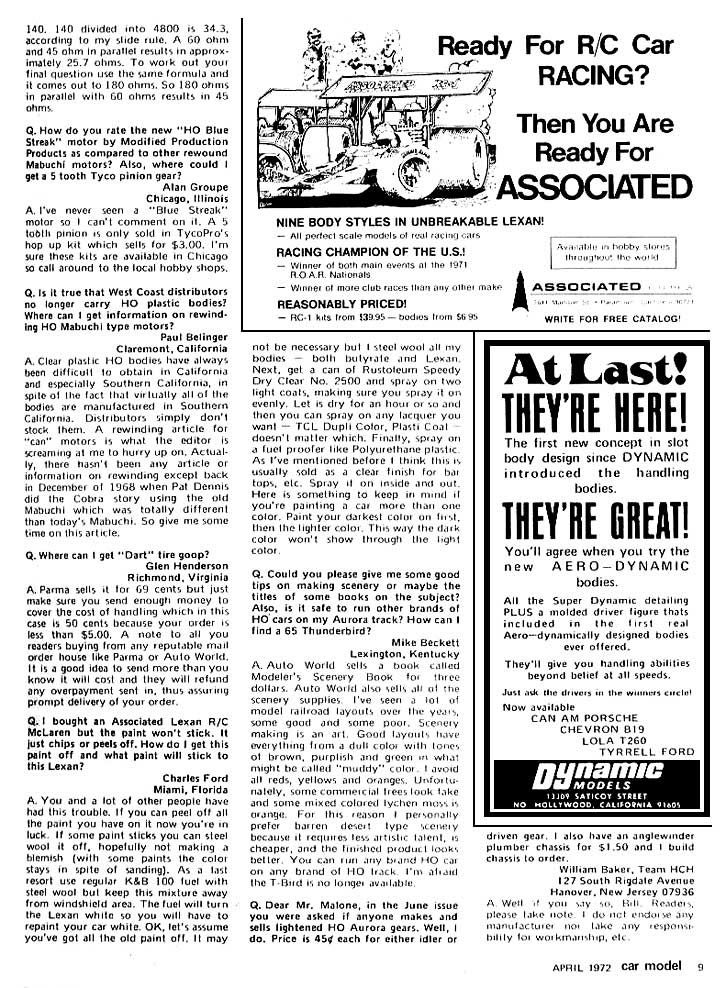
August 1971, Car Model: Thorough track testing of the DynaBrute. Ed Bianchi reveals the true nature of the beast.
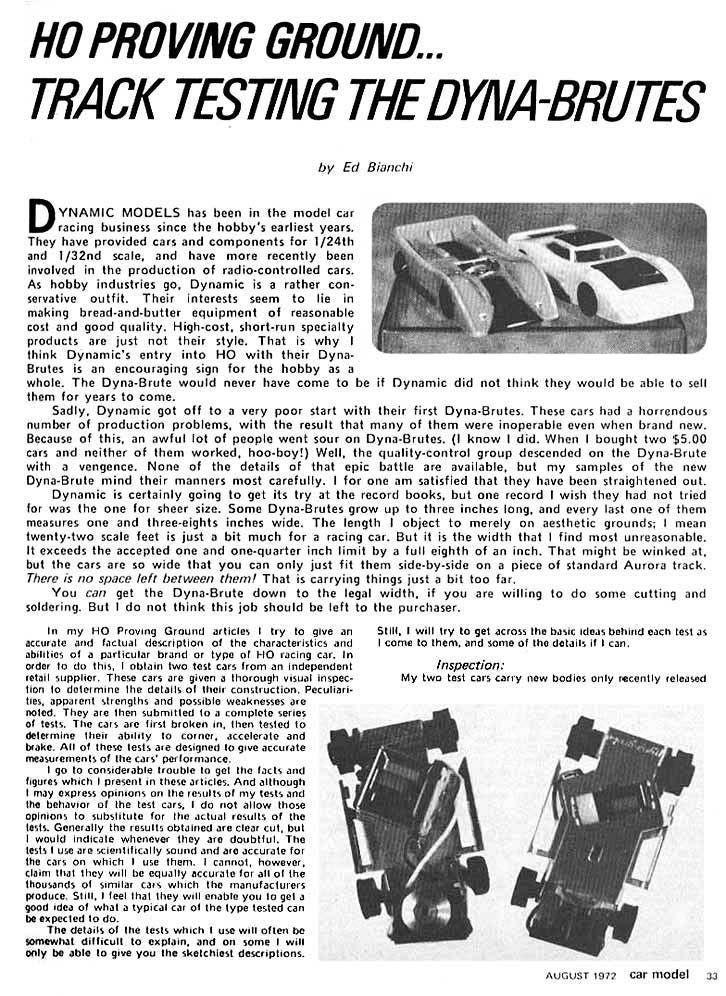
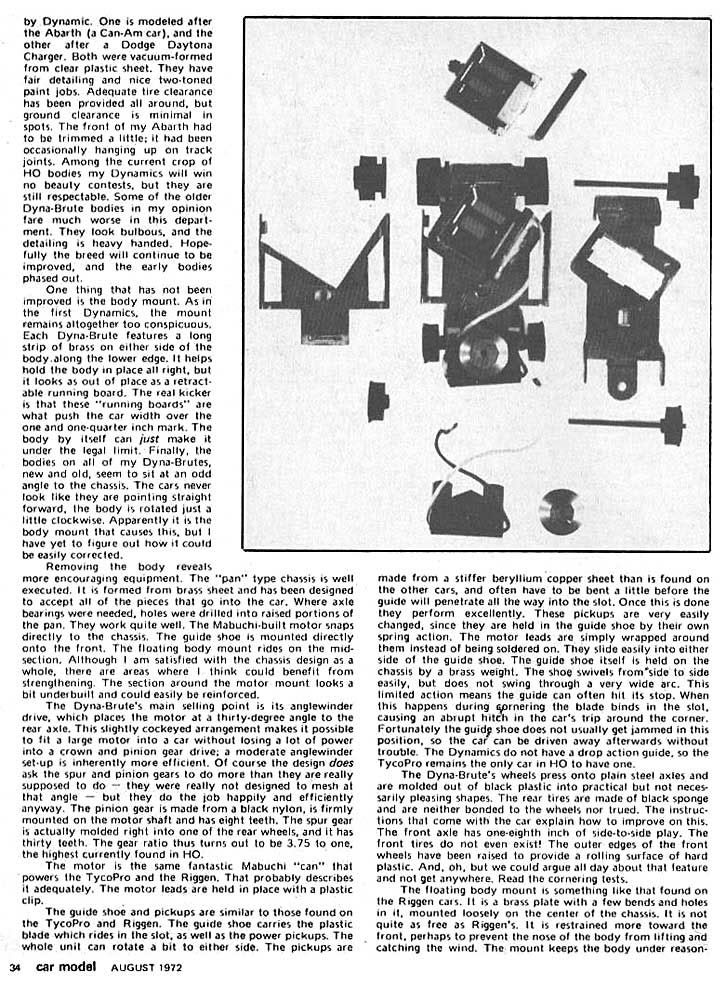
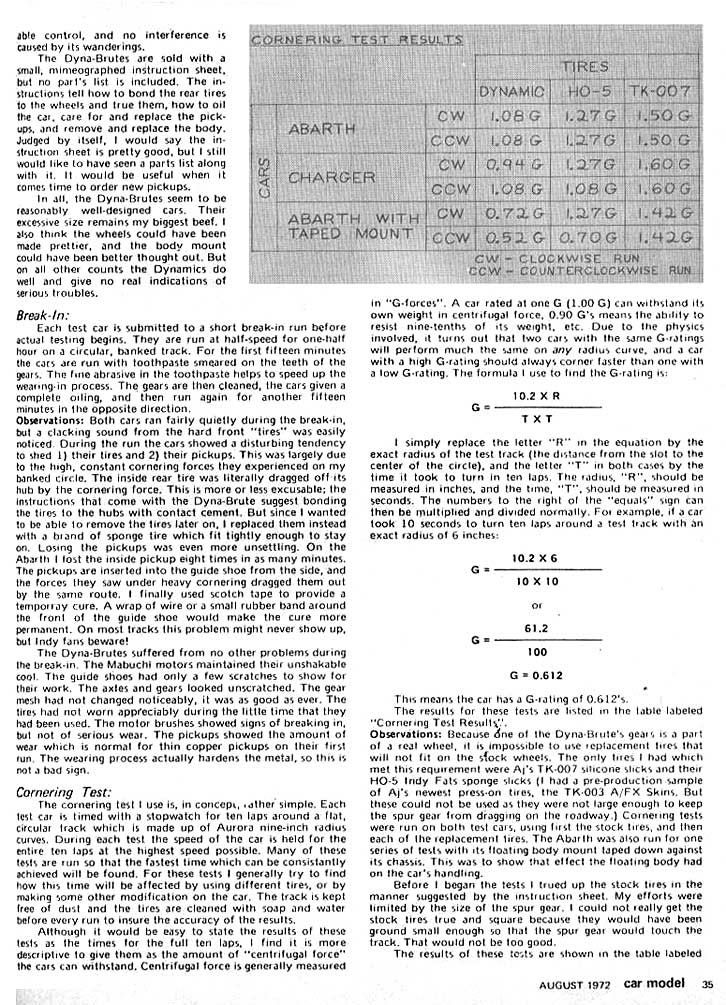
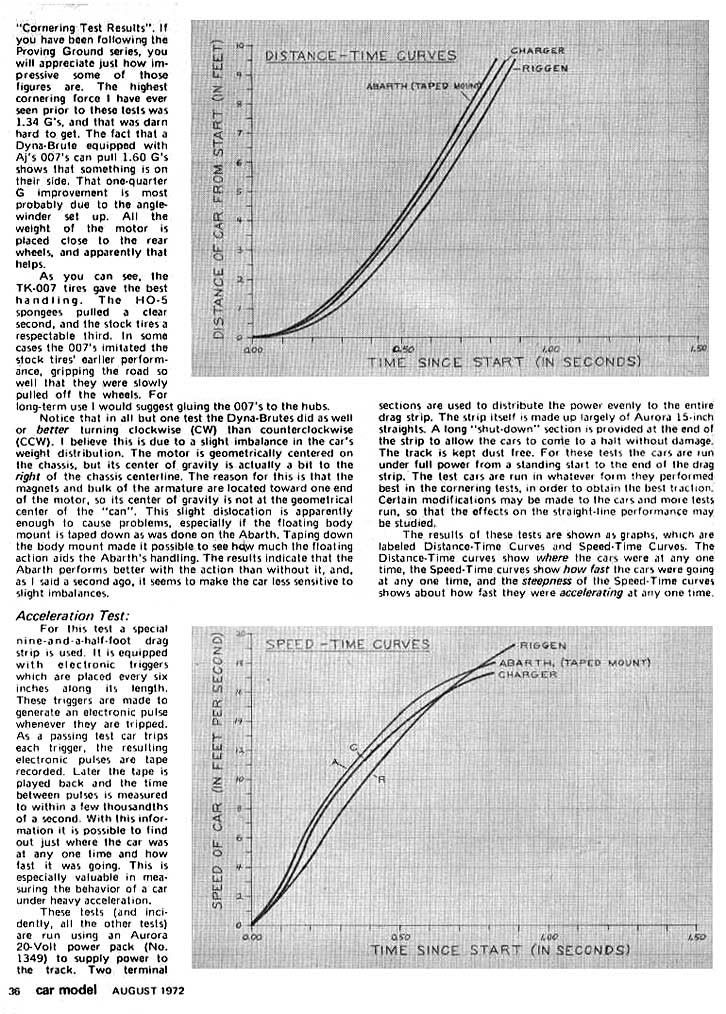

August 1971, Car Model: The very first Dynamic ad was published in Model Car Science in august 1963.
The very last Dynamic ad was published exactly nine years later, in Car Model in august 1972. This is it!
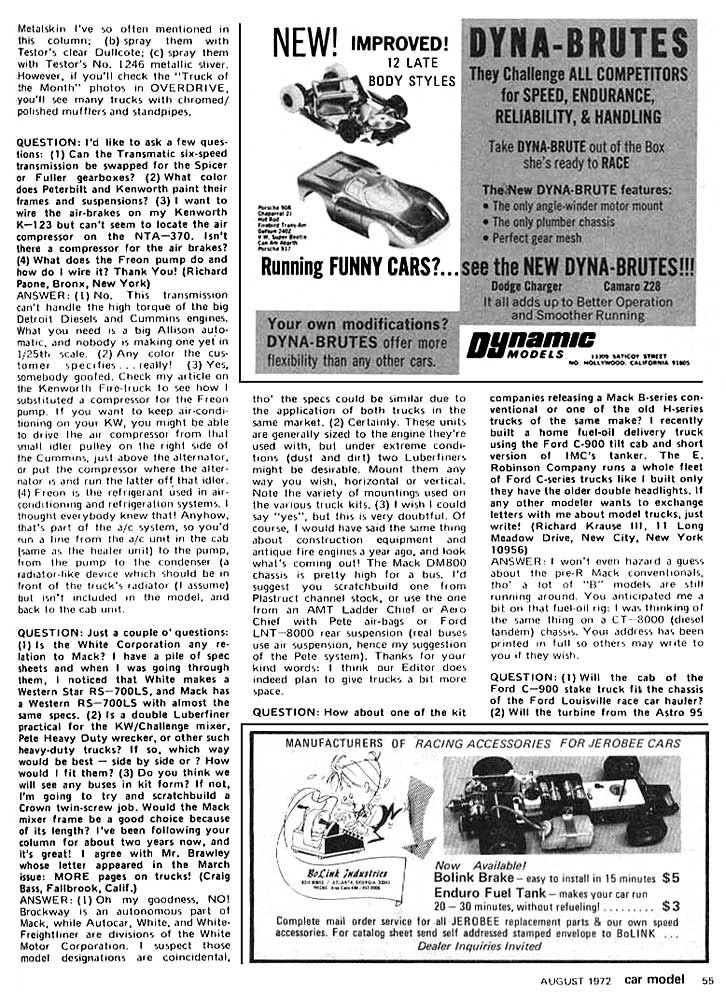
Overseas Observer
#63

Posted 01 November 2010 - 01:25 PM
Local track owner has several La Cucarachas. And loves to tell the story of how when these showed up, they took over his local racing in the chicago area. He keeps suggesting a vintage rtr race at the track.
So, I finally got around to taking one of my original Dynamic anglewinders over to show him. The rubber is only 2o years old, the rest is original. Including the body! So, he does one lap........ONE lap and say "no vintage racing FOR YOU!".
Grin.
Fate
3/6/48-1/1/12
Requiescat in Pace
#64

Posted 07 November 2010 - 02:14 PM
Apparently ”Hi” and his company was into a lot more than slot car racing...
More hereDynamic Models Inc of Van Nuys, California, was founded in 1955 by Howard Wilde Johnson, better known as "Hi" Johnson. He was also one half of the Kenhi Models partnership which closed the doors in the same year. Johnson was well known for the attractive control line models he'd designed under the Kenhi label. Earlier that year he had purchased the Orwick engine project from Henry Orwick's widow and produced a number of Orwick/Johnsons from the parts inventory. Dynamic Models was formed to manufacture and market his own engine developed from the Orwick glow. The first advertisement for Johnson engines appeared in the July 1955 issue of Model Airplane News where the range were called somewhat futuristically, the 1956 engines.
The Ken of Kenhi was Ken Adams who had owned the machine shop where the post war Atwood engines were made.
Howard Wilde (Hi) Johnson was a for-real aero engineer. He graduated from Cal Aero during The Depression and worked for Northrop Aviation in the 1940's. He loved all forms of aviation, surviving the Northrop Flying Wing crash that killed Richard DuPont. He was killed in 1981 when he pulled the wings off the sailplane he was piloting.
As well as the Johnson engines and model accessories, Dynamic Inc manufactured the Holland Hornet and the short-lived and un-loved Bulldog 09. To go with the Automix throttle, Hi Johnson designed and sold an auto-pitch two blade prop that reduced the pitch as the rpm decreased, the intent being to produce less thrust at higher idle speeds. This unit also featured replaceable blades.
In my neck of the woods in the late 1950's and early 60's, Johnson was the engine to have. In preparing this page, I re-read all of Peter Chinn's Johnson reviews: three in MAN and one in the British magazine, Model Aircraft. Illustrating magazine lead times, this latter one appeared after the company had disappeared. Chinn always gave the engine top marks and so do I.
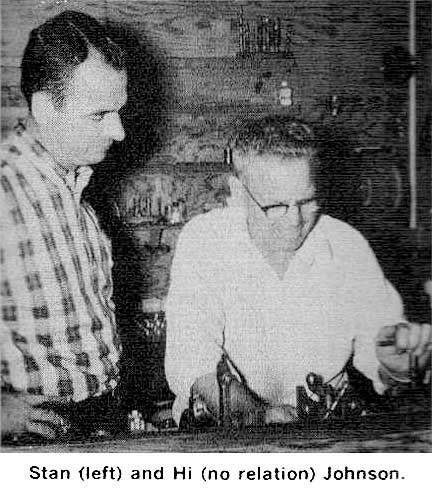
Our first meeting with Hi Johnson at the Van Nuys (California) plant of Dynamic Models Inc., found him turning out a batch of new cylinder heads which he figured should boost the already potent output of his Johnson .35's. Hi is always ready to stop work and talk to "visiting firemen"— which he promptly proceeded to do. We were at the plant to get the story of its founding and the first experiences of "Mr. Dynamic" in model plane building. Seems H. J. found a design for a flying model in a rather ancient school library book. Being 1923 — and in Northern Utah — there were no hobby shops nearby, so apple crates were cut up for the necessary wood, cement was made by boiling down pigs feet (he lived on a ranch), and the plane slowly took shape. Finished in late November, it had to be equipped with skis for the first trials. To his utter amazement the plane rose off the snow, travelled some 50' at an average altitude of 30'. Success!
After he entered high school he continued to build models until his Senior year when something in the same line, but much bigger, occupied his interest. With a few pals he constructed a full size "boy-carrying" glider, the first ever built in the state. It was taken out and flown on nearby dunes, left staked down at night. Why no necks or other human parts were not broken Hi doesn't know—but the parents of the budding aviators must have become more and more worried as the flights grew longer and more daring. For when the young fliers reached the dunes one day, they found their glider chopped to bits. As Hi quietly puts it, "That ended the glider phase".
He built his first gas model in 1939, a Fireball ukie with a Bullet engine, flown on the end of fishing line. At the time he had no idea of going into the model biz—this urge came after he had spent seven years as an aero engineer at Lockheed. Once out of big plane design and into the little ones, he found his engineering experience most useful. In fact he still treasures a dog-eared set of old NACA reports, refers to them constantly. Hi notes that up until the time Lockheed got into the very high speed (for that time) P-38, many of the planes he worked on operated in Reynolds Number ranges comparable to models and their props.
Late in 1945, Hi formed Burbank Mfg. Co., turned out kits for the Madman Jr. and Sr., Go-Devil Jr. and Sr., and Johnson built props. This firm was absorbed by Henry Engineering Co. (Veco Products) and Hi was a partner there before leaving to form KenHi with Ken Adams. Again the product was model plane kits, some of which are still marketed (Midwest Products is kitting the Johnson Cougar, may do some other old Johnson designs).
When the Ken-Hi partnership was dissolved, Johnson went to work for Litton Industries. This firm had considerable grinding done at the little plant of Henry Orwick, who was then producing the hot Orwick engines. Henry had decided custom grinding was a lots better business than making model engines, offered to sell Hi all his tools and Orwick engine parts at very low cost. Thus Hi found himself for the first time in the model engine business and produced 5000 copies of what was the first Johnson engine. Hi then went into a real study and development program on small engines, turning out, as he puts it, "a 20 gallon barrel" full of experimental jobs, until he finally had what he wanted. By this time money in the young firm of Dynamic Models had run out, and he had to take a full time job in order to eat, meanwhile trying to produce the new engine design at night. This soon proved to be a hopeless setup—he figured it would take some 10 years of day-and-night work before the model company could support him full time.
Fortunately at this juncture an angel appeared. Bill Jameson (with whom Hi had worked at Litton land who was VP and Chief Engineer at the time) put up sufficient money to get the model firm going on its own and Dynamic Models was finally on the way. Business-wise this was fine, but Johnson points out he has had little time for model building and flying since. In fact he hasn't done any competition flying in 20 years. Dynamic moved to its present location in '59.
In 1960 the concern bought out Holland Engineering and Bob Holland was added to the Dynamic staff. An extensive development program was started, one result of which was the Holland Hornet (which took more Nats places in 1962 than it had in '61 and has had continuous small improvements ever since). This, by the way, was the first engine of anywhere near this size with variable speed carbo Bob stayed at Dynamic till the end of '61, when he went into the Missile Division at Lockheed. But before he left he had designed a small engine of which Dynamic produced well over 100,000 copies, for a large firm then just getting into the model field. During the period these engines were pouring out of the plant, there were as many as 45 employees at Dynamic (the present average is 16) and they had to work in several shifts. Holland still does some consulting work and engine testing for Dynamic.
Most modellers don't realize that there is another Johnson holding a vital position at Dynamic. This is Stan, no relation to Hi, who joined the firm in '59 to help out on management problems. Raised in Northern California, Stan had studied economics, had worked in many countries in the farm equipment business. Starting in this line in Detroit, he went to Toronto, then to South America, living in 11 different places within the space of 10 years. Back in California, he worked first on a part time basis at Dynamic, then full time. Stan handles the business end-sales, promotion, advertising, pricing.
Another essential employee, who has been with the firm since 1948 is chubby, smiling Jack Garcia. Competitors in Combat, Rat Race, Team Racing and other speed events know Jack well; he is very active and very successful in these fields. Along with Hi, Jack attends every Nationals; while Hi takes care of "public relations" for Dynamic, considers new products they might manufacture, Jack takes along a good stock of engine parts, makes sure that Dynamic engines owned by Nats contestants are working at peak efficiency. Jack also handles engine hopup work at the factory, assists Hi Johnson in special jobs.
The engine range includes the potent Johnson .29 and .35's (which won all Combat categories in the '62 Nats, repeated again in '63, won many other places as well); there is a BB .36 in this series, with the Johnson AutoMix carburator, intended for R/C and other variable speed flying. Several factory hop-ups are offered on these engines. At the small end of the line we find the Holland Hornet, made in both .049 and .051. The Bulldog .09 is a compact and hot little job that may also be had with variable speed fittings for R/C purposes; it is a Hi Johnson design (with Holland consultation), very light for its power.
Dynamic accessories are very numerous, include countless sizes and types of control line cables, 4 types of glow plugs, replacement glow heads for several makes of engines, R/C wheel brakes and carbs. Still stocked is the Auto Pitch prop; however, replaceable blades with considerably more area are now made for this unit. The hub is sold separately, blades in several sizes are extra. This is not a variable pitch prop; it is intended to operate at only two pitch settings, one for normal flying, one for low speed.
Latter will allow "idling" at 5,000 to 6,000 RPM so no fussy carb settings are required. When in low pitch (can be adjusted to suit your plane and engine) the prop offers considerable air resistance—you can even set it to give negative thrust. This produces a steep glide, can take the place of flaps on an R/C plane—but does require a different landing technique. In an effort to level out seasonal variations in the model plane line, Dynamic has gotten into the rapidly expanding slot racing car field. They started with wheels of several types, precision axles in a variety of lengths, and knock-off style wheel nuts. A large slot racing track has been built (atop Hi Johnson's office and shop) so that products in this field may be thoroughly tested.
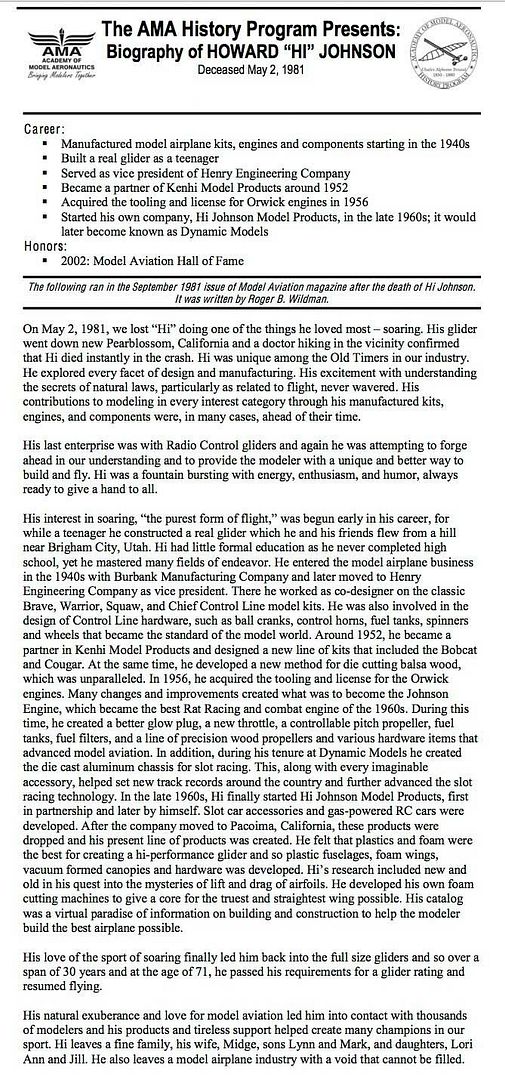
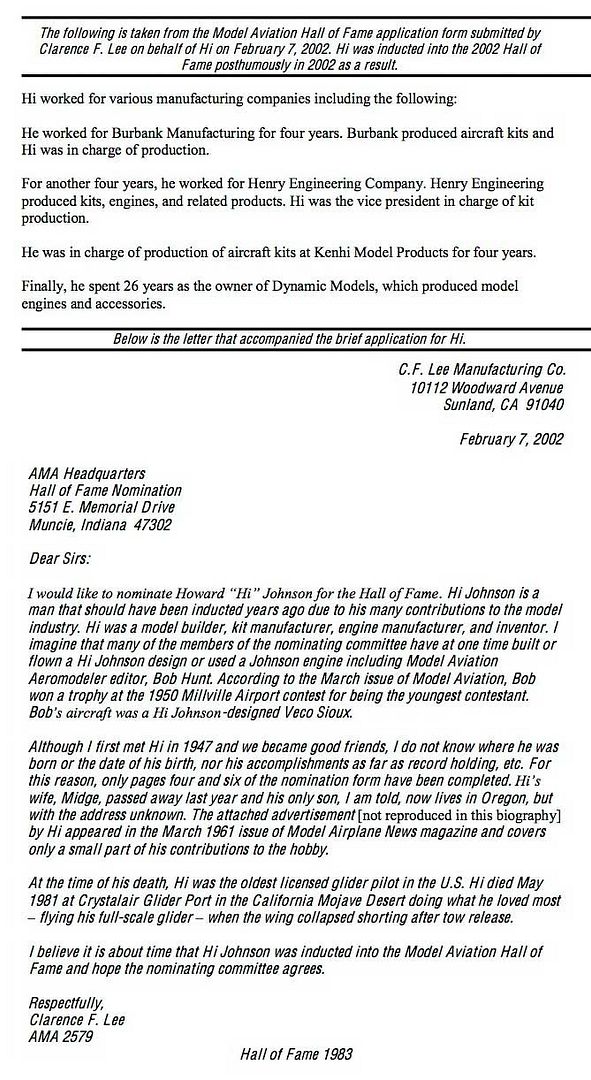
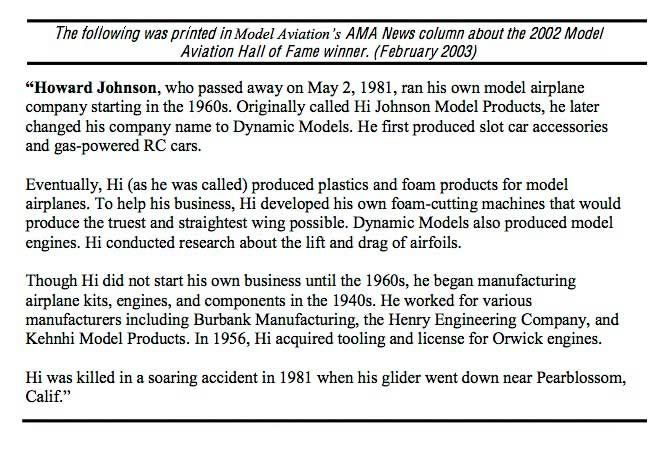
Overseas Observer
#65

Posted 08 November 2010 - 06:08 PM
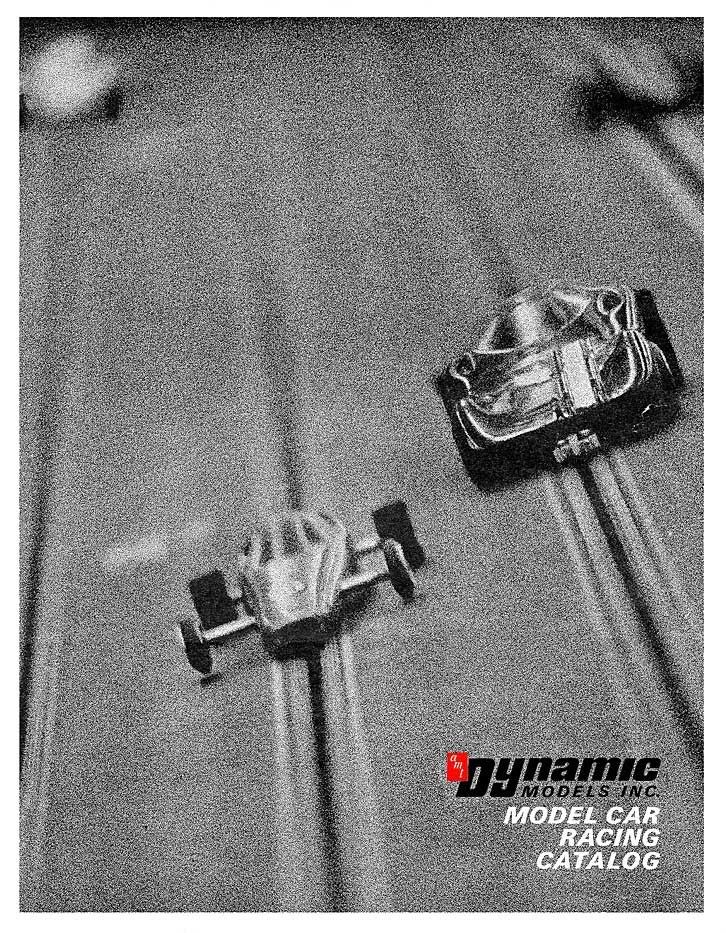
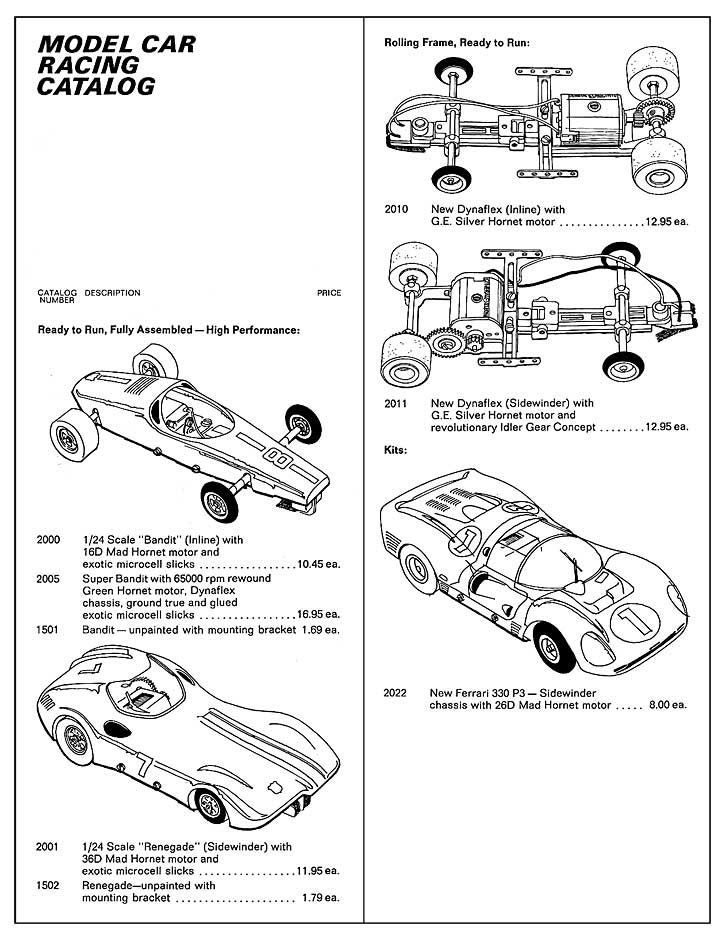


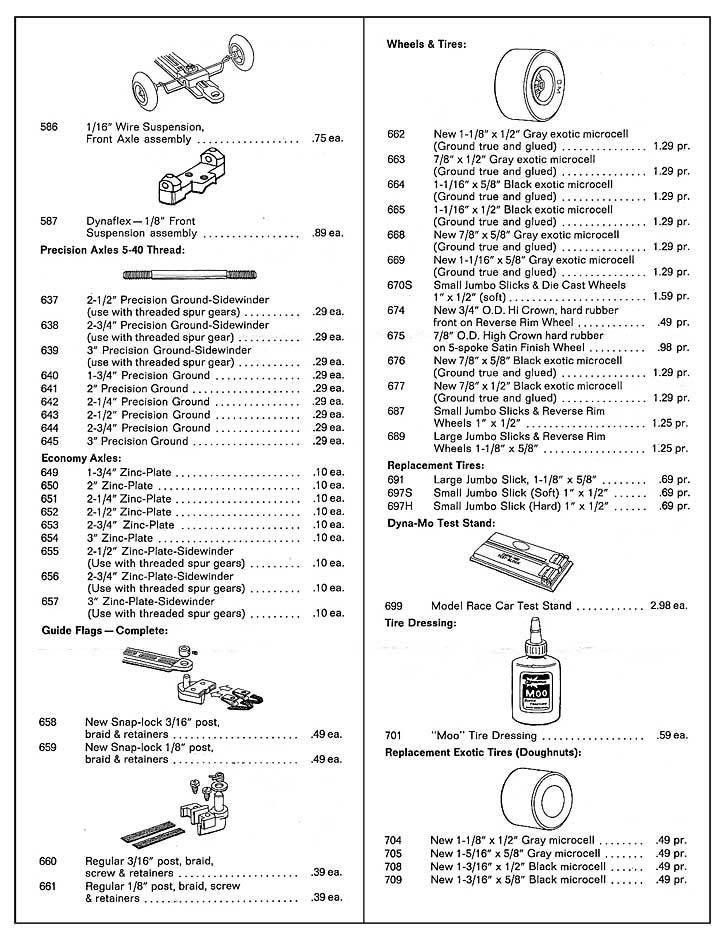
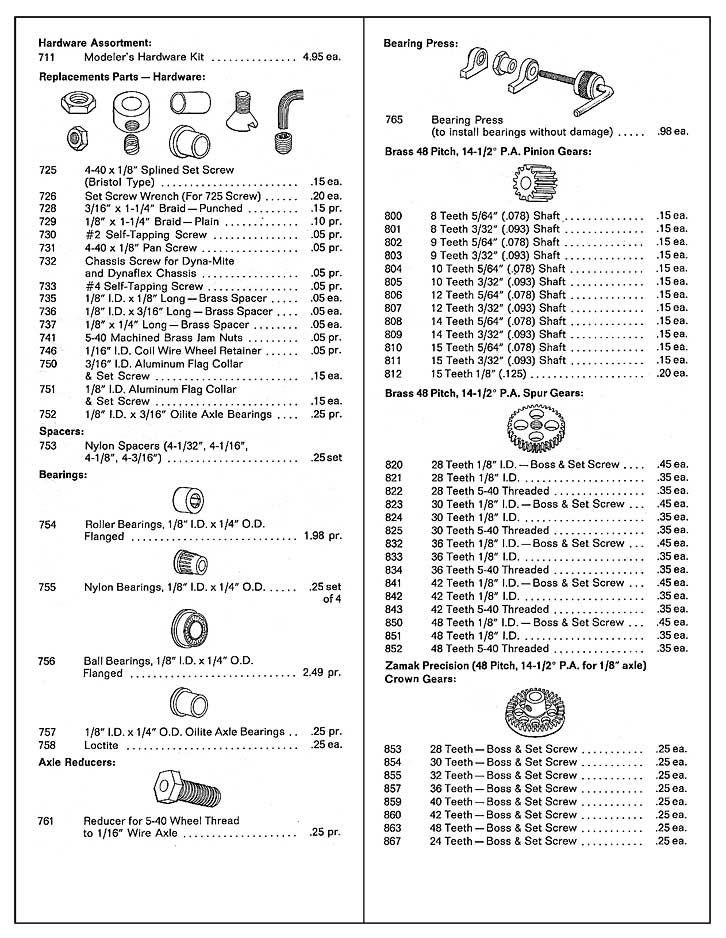
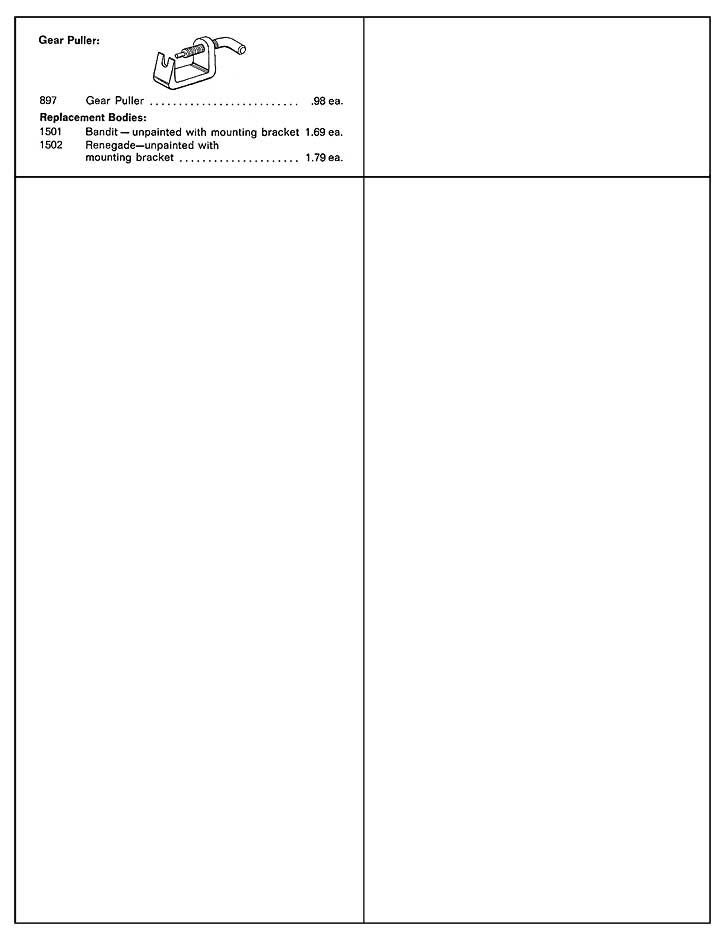

Overseas Observer
#66

Posted 08 November 2010 - 06:40 PM
This article has lots of inaccuracies in it. One of them is Mr. Johnson's name. His first name was not "Howard" but Hiram. the nickname "Hi" came from his name, Hiram. If he had been called "Howard", there is a good chance that his nickname would have been "Howie".Dynamic Models Inc of Van Nuys, California, was founded in 1955 by Howard Wilde Johnson, better known as "Hi" Johnson
A more accurate history will be seen in the Dynamic chapter of our new book. I worked for a while for Hiram Johnson and should know how he was named as he signed my paychecks for a while.
Philippe de Lespinay
#67

Posted 08 November 2010 - 06:53 PM
.
Although I've never seen these 1965 models of the Mustang and Cobra as RTR cars, the bodies were sold in Dynamic packaging just like the other parts. I bought the Cobra body sealed in a card package and besides the windshield packed under the body, for protection, there was a brass chassis mount meant to convert the original side body mounts to accept a Dynamic chassis.
These bodies were in fact the AMT slot kit bodies from 1965 but the Cobra was cast in grey plastic, and I have only seen red Mustangs but there may be other colors, too.
I was going to build the Cobra up with a Dynamic chassis but the original front body post had been designed to fit the AMT aluminum ladder type chassis and I realized I would have too cut it off to get the Dynamic chassis to fit right, so instead I scrounged up a used AMT chassis. I converted the motor to a 36D (from the original grey 35R) which I had seen in one of the Mustangs which appeared to have been converted to a Green Hornet 36D with a factory-made modified motor mount. I never noticed this conversion part listed anywhere.
Gb
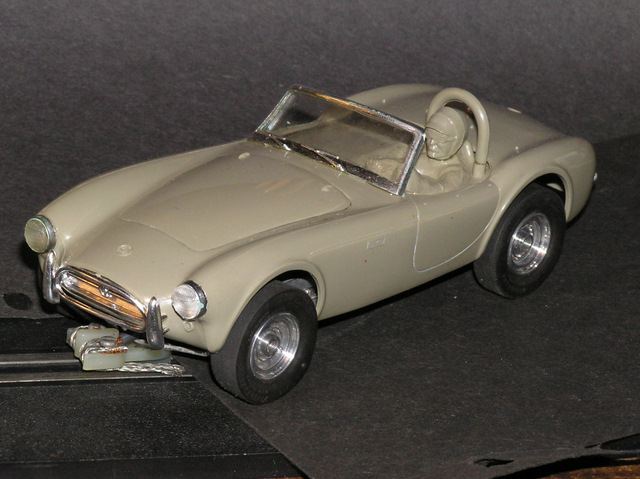
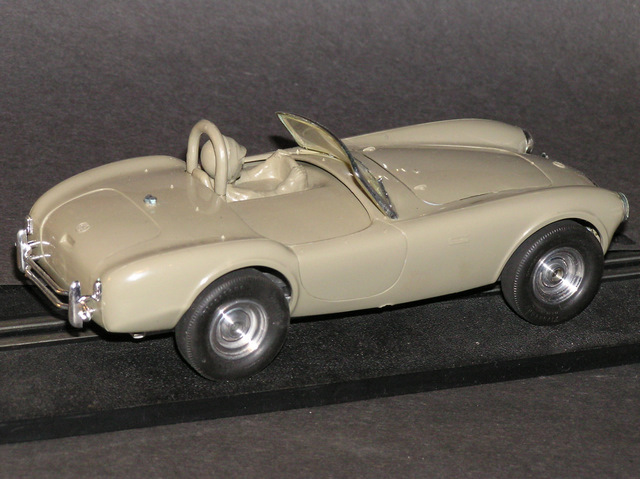
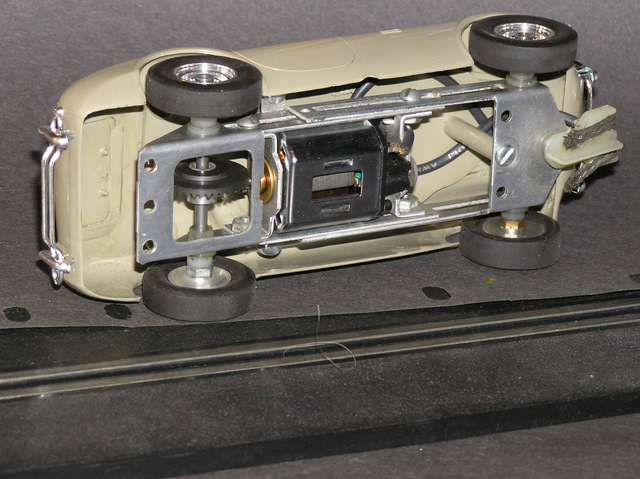
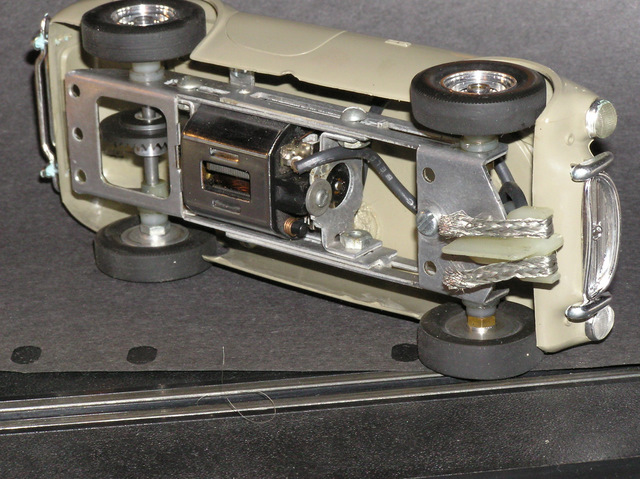
#68

Posted 08 November 2010 - 07:34 PM
While prototypes were built and (obviously) shown, production never began. I was told that the body mount as devised was insufficient and caused the body to rock over the frame too easily, so the project was simply canceled. Indeed if you own one of these mounts (some were sold by REH all the way into in the 1990's), you will find this to be correct.
What survived of this minor mess were the well-known body kits, marketed in typical Dynamic packaging, since the bodies had already been produced . The same body colors can also be found on the AMT kits, so nothing special was created.
Philippe de Lespinay
#69

Posted 09 November 2010 - 03:41 AM
The Dynamic Mustang and Cobra RTR models, announced in that article, were never issued. They were to use the AMT bodies, produced in red (Mustang) and gray (Cobra) set over an inline die-cast aluminum Dynamic chassis, a stamped sheet brass body mount and a Russkit "33" motor. They were never designed to use the AMT stamped aluminum 2-piece frame.
While prototypes were built and (obviously) shown, production never began. I was told that the body mount as devised was insufficient and caused the body to rock over the frame too easily, so the project was simply canceled. Indeed if you own one of these mounts (some were sold by REH all the way into in the 1990's), you will find this to be correct.
What survived of this minor mess were the well-known body kits, marketed in typical Dynamic packaging, since the bodies had already been produced . The same body colors can also be found on the AMT kits, so nothing special was created.
#70

Posted 09 November 2010 - 06:36 PM
the GE motor w. accessories is gone. Also the knock-off nut wrench has got a new design & shape.
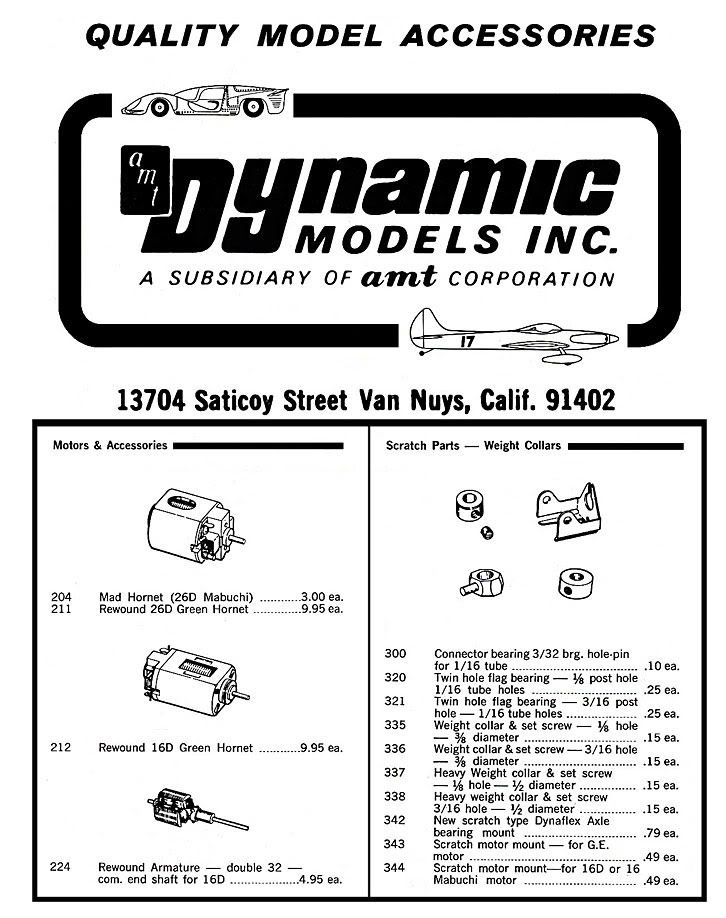
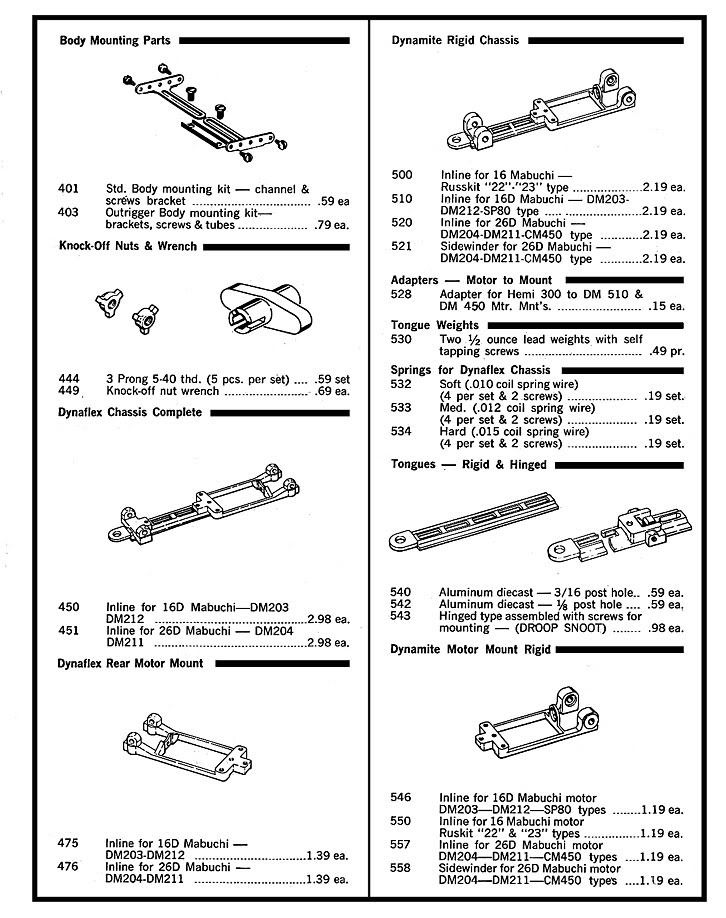
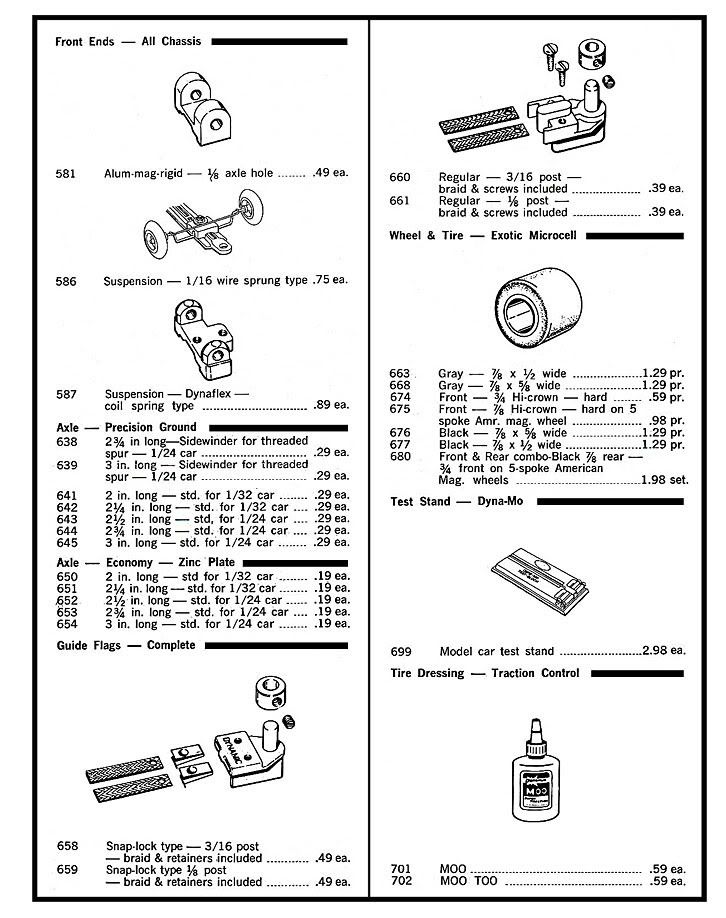
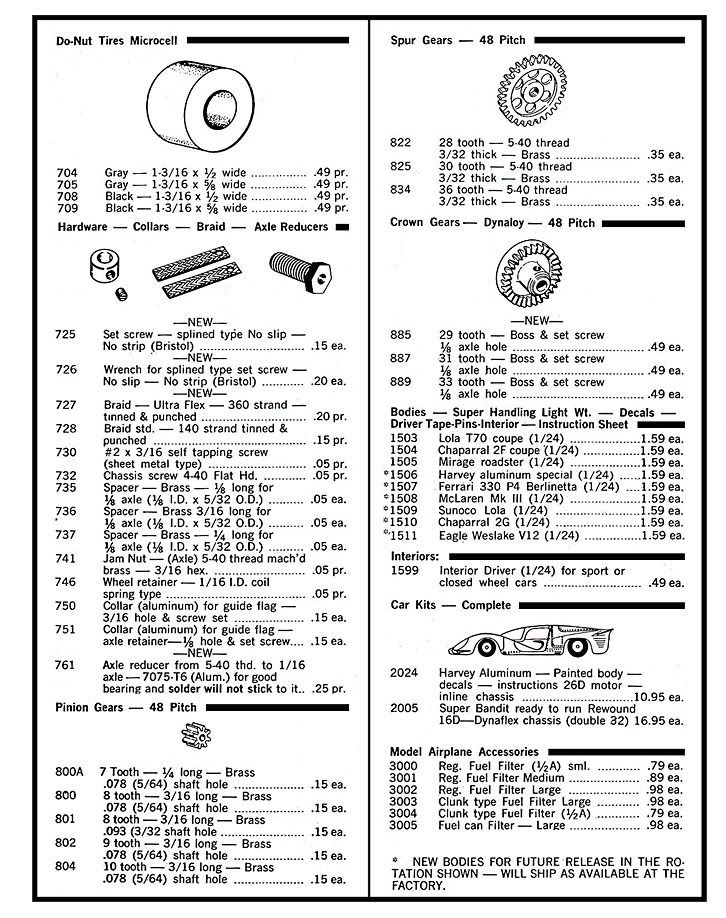
Overseas Observer
















